Swansea City almost delivered an incredible FA Cup shock on Saturday evening as they got themselves into a 2-0 half-time lead over quadruple hopefuls Manchester City at the Liberty Stadium. Pep Guardiola was left stunned when Graham Potter’s side cut through Manchester City’s high press as Bersant Celina finished off a superb attacking move to double the host’s advantage after 29 minutes following Grimes’ opener from the penalty spot.
With 21 minutes of normal time remaining, the visitors got a goal back through Bernardo Silva. The controversy and discussions concerning the absence of VAR then occurred nine minutes later as Raheem Sterling won a penalty when it looked like Cameron Carter-Vickers got a crucial touch on the ball to see it roll out of play. Aguero also looked like he was standing in an offside position as he glanced a header in past Kristoffer Nordfeldt.
Despite the late controversy surrounding the goals in Manchester City’s comeback, it was a thrilling FA Cup tie played between two sides who played on the front foot and looked to cut through the opposition’s high press.
Lineups
Swansea City manager Graham Potter made one change to the side that lost 3-0 at West Brom in midweek. Kyle Naughton’s injury from that game meant that Potter surprisingly went for Cameron Carter-Vickers at left back despite the left-footed Grimes playing there on numerous occasions this season.
He slotted in alongside former Ajax defender Mike van der Hoorn at centre-back. It was a bold decision from Potter and it’s something we’ll look into in more detail in this tactical analysis.
Daniel James provided an attacking outlet in a wide left position with Wayne Routledge playing through the middle and Bersant Celina dropping in between the lines to link up the play.
Pep Guardiola looked to use the width during the game with Mahrez and Sane stretching Swansea as full-backs Kyle Walker and Fabian Delph offered inside support in attacking build-ups.
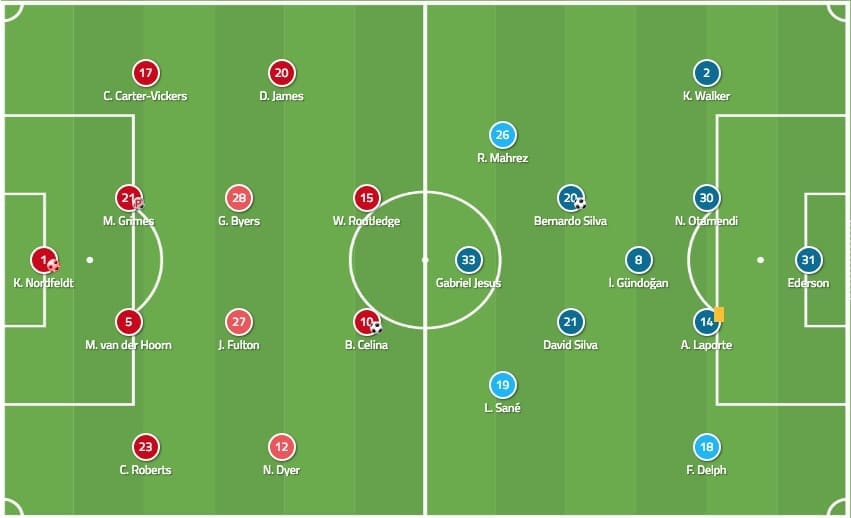
The battle of the high press and cutting through it
Swansea City were brave in their approach to the game as they, like Manchester City, adopted a high press, committing four or five players forward to add pressure on the opposition back line.
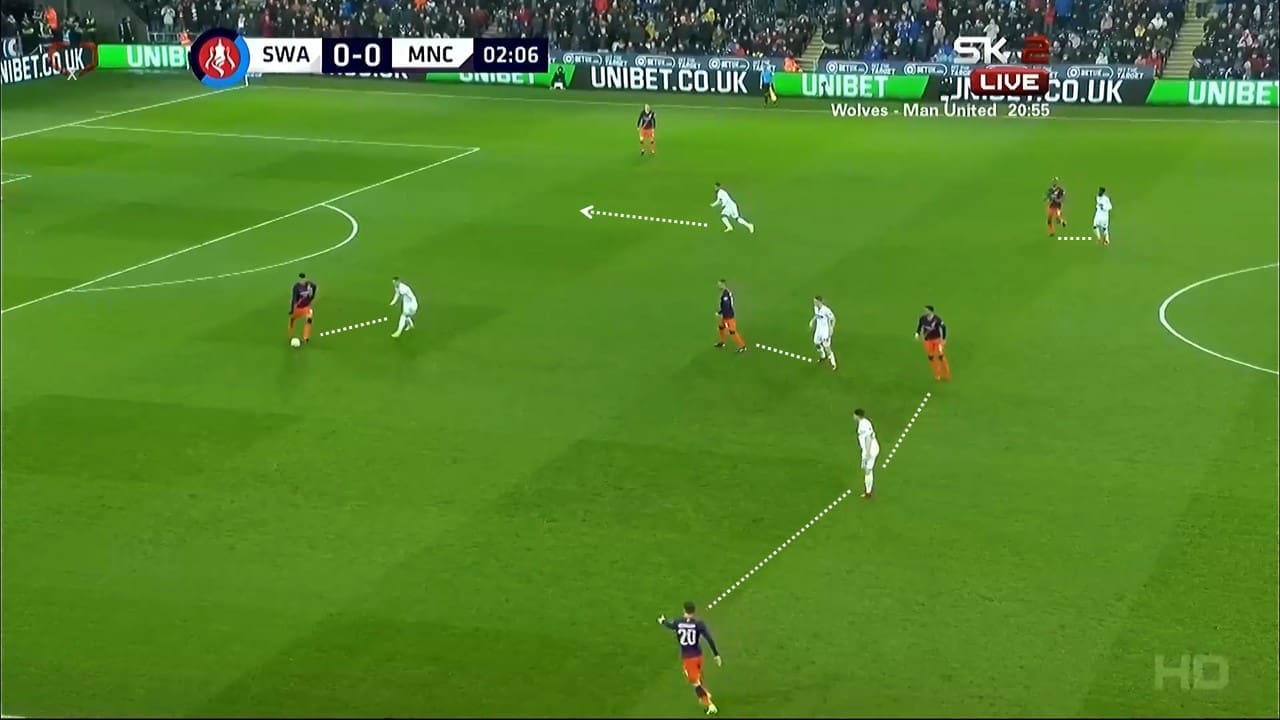
More often than not, Manchester City had the quality and ability to bypass Swansea’s high press. Those players involved in the high press had to be quick to drop back into a deep defensive shape to close off the space that they left behind.
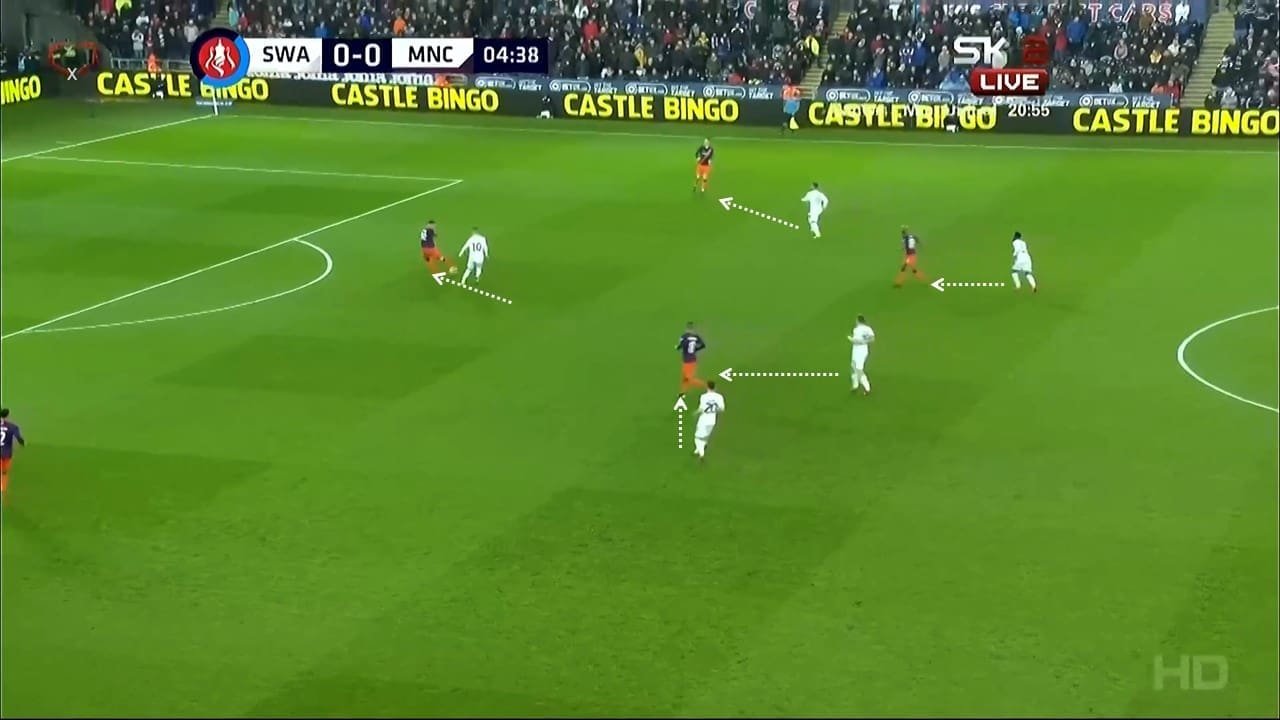
So bold and brave was Swansea’s approach that they even committed as many as seven outfield players to press deep in Manchester City’s half. In the example below, Jay Fulton, used as defensive cover when Grimes moved out of his centre-back position, presses the player in possession with his midfield teammate George Byers joining in the press ahead of him.
Matt Grimes is at the base of the high press. Bersant Celina at the top blocks passes back to the goalkeeper and Wayne Routledge blocks the passing lane to left centre-back Aymeric Laporte.
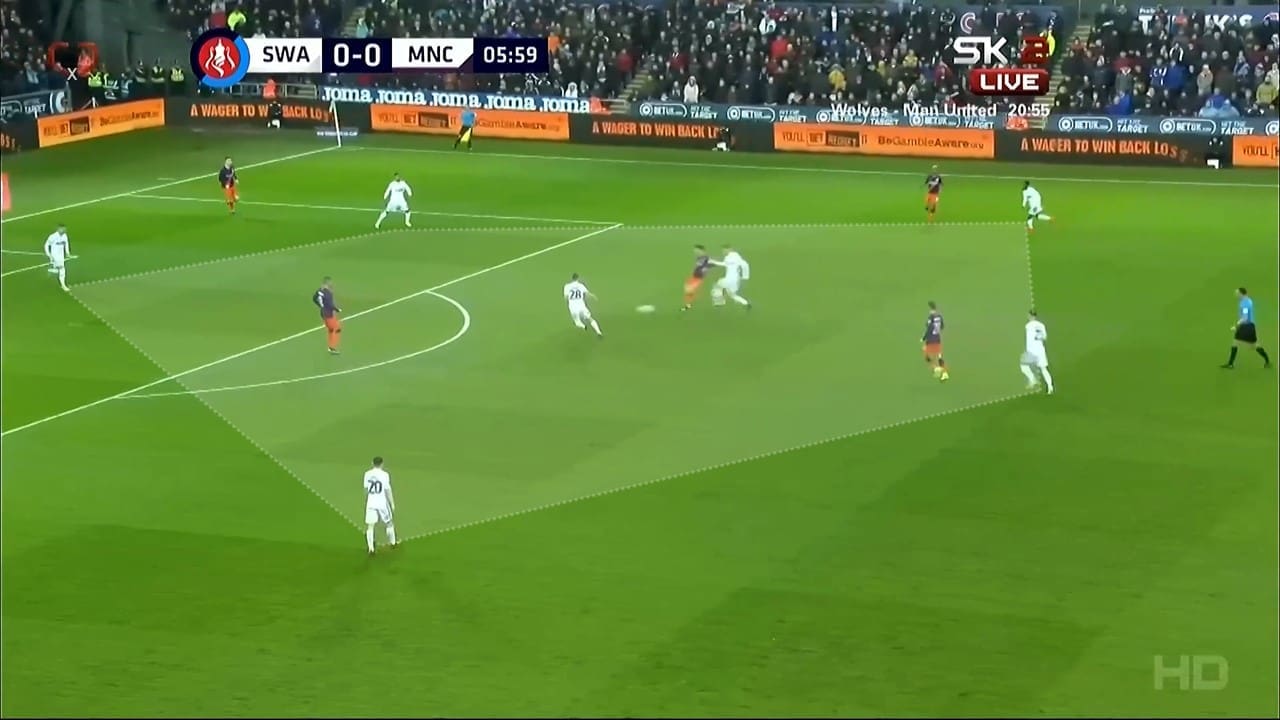
Manchester City were able to bypass Swansea’s high press on many occasions, allowing them to use the space in behind it to create goalscoring opportunities. A combination of good saves from Nordfeldt, poor final balls and decisions from Sane and Mahrez plus the odd bounce of luck for Swansea kept the visitors at bay.
Despite Swansea’s well-executed and positioned press (above), Manchester City were excellent at passing their way around and through it. This allowed them to get into space and gain a numerical advantage against the home side’s three remaining outfield players behind the ball (below).
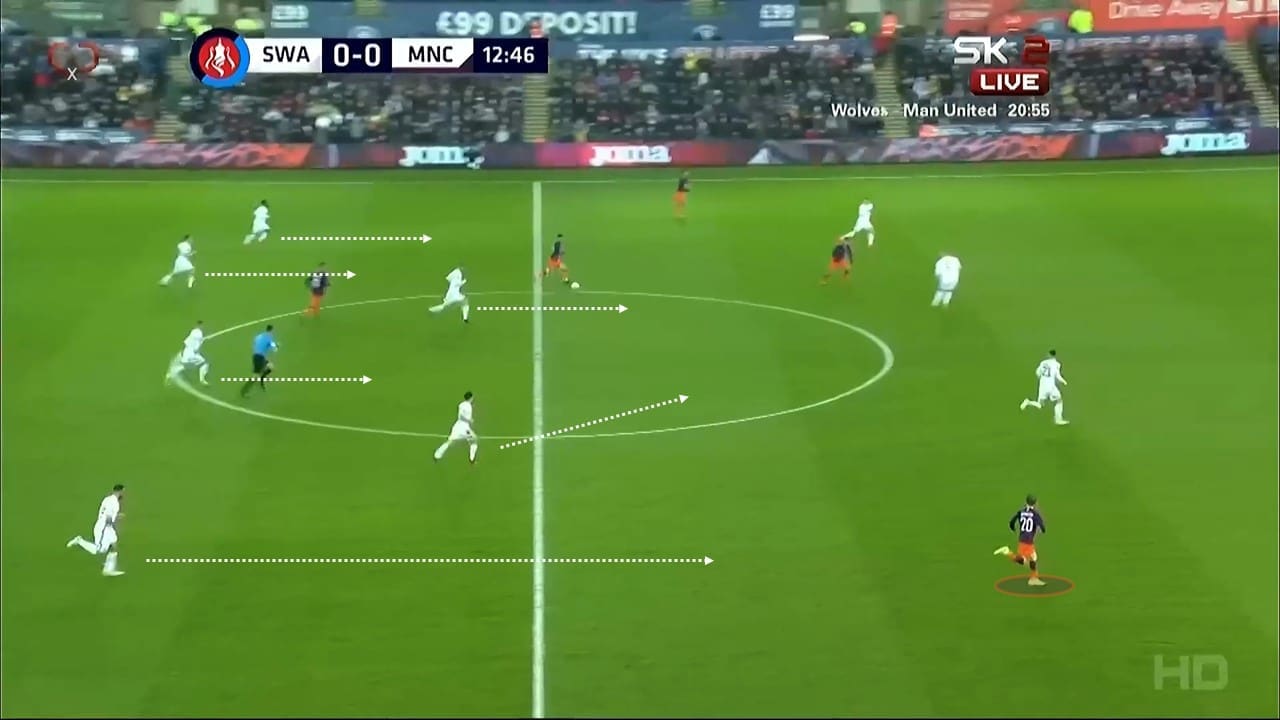
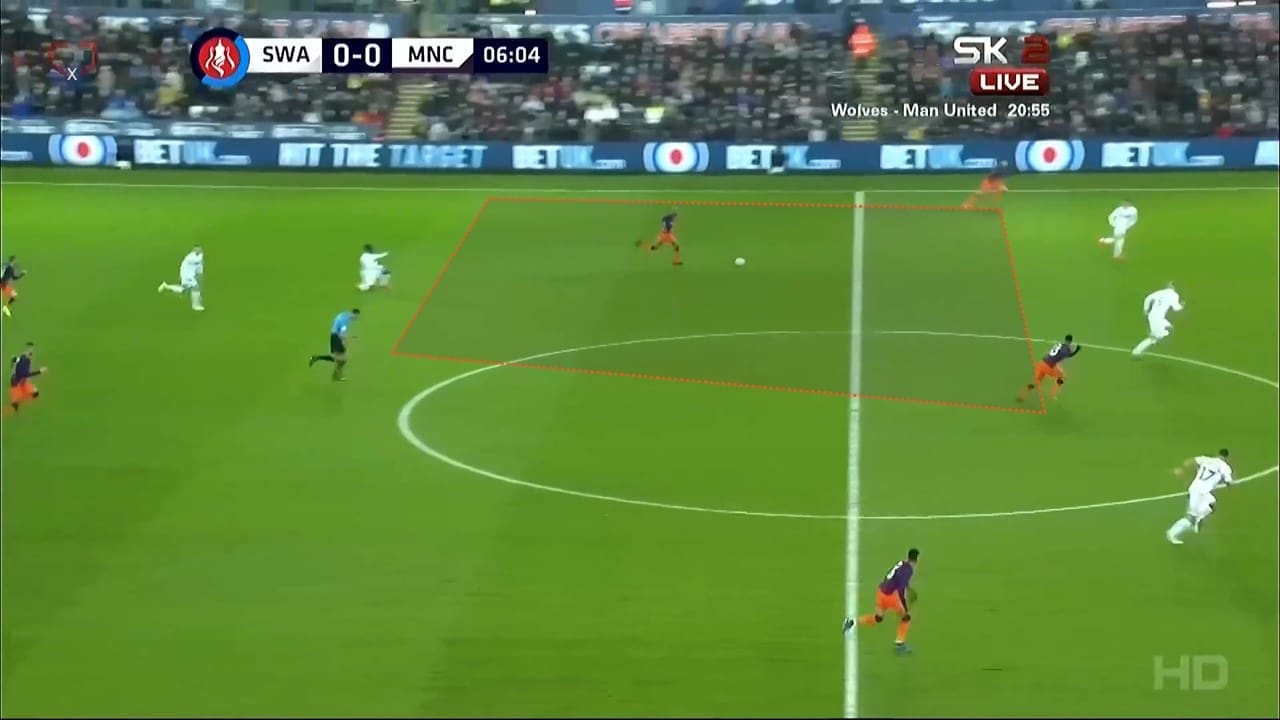
Swansea City were committed and disciplined in executing Graham Potter’s ambitious game plan. After bypassing their press, Swansea’s players raced back to cover and they ensured they got themselves back to add defensive cover across the front of their six-yard box (below).
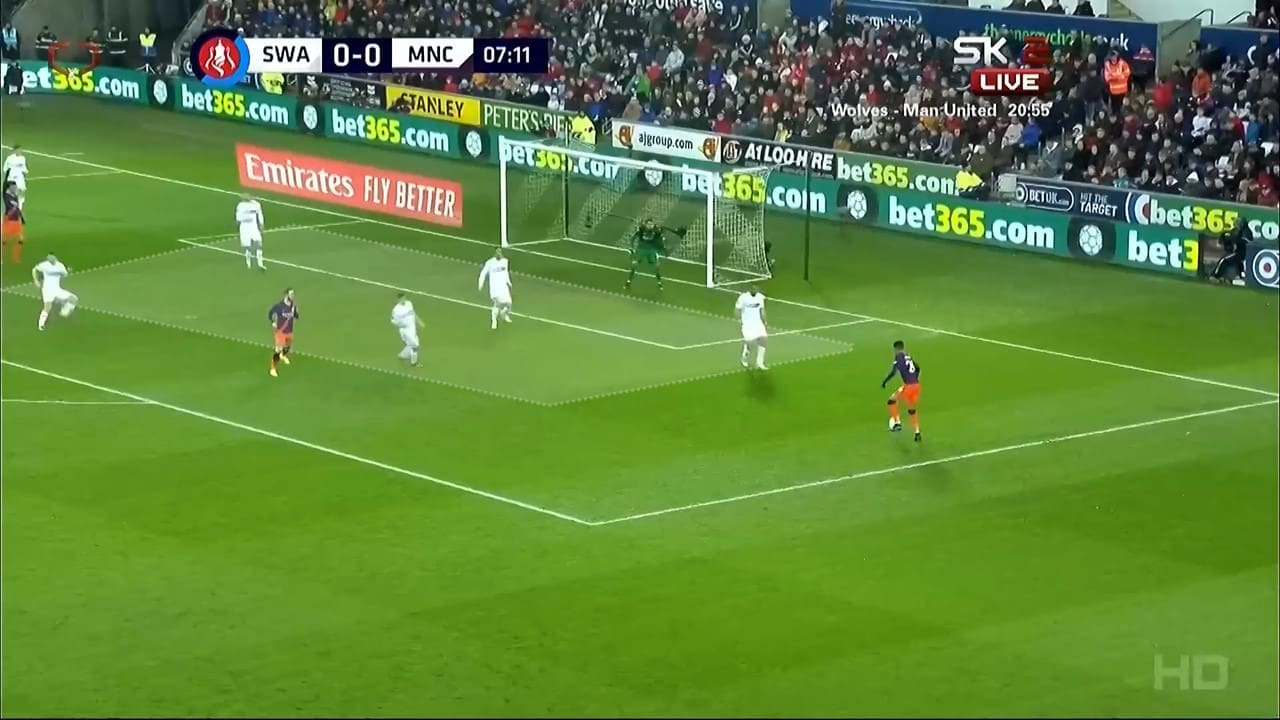
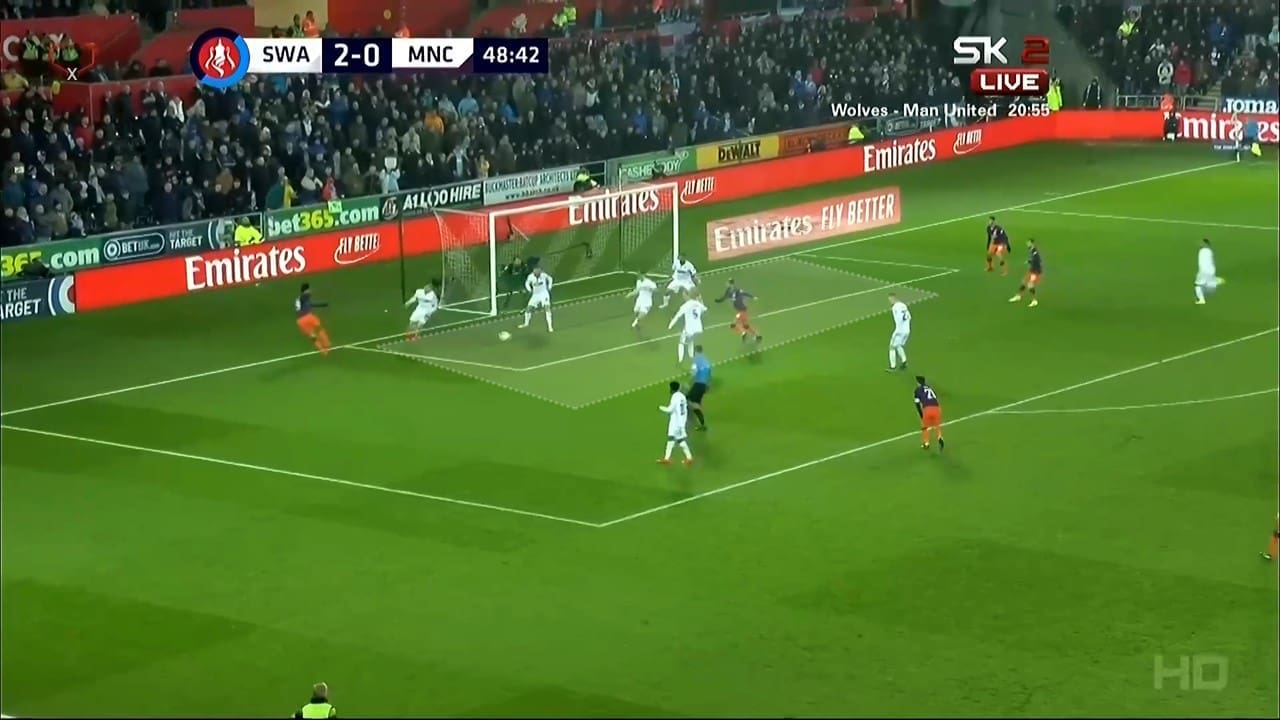
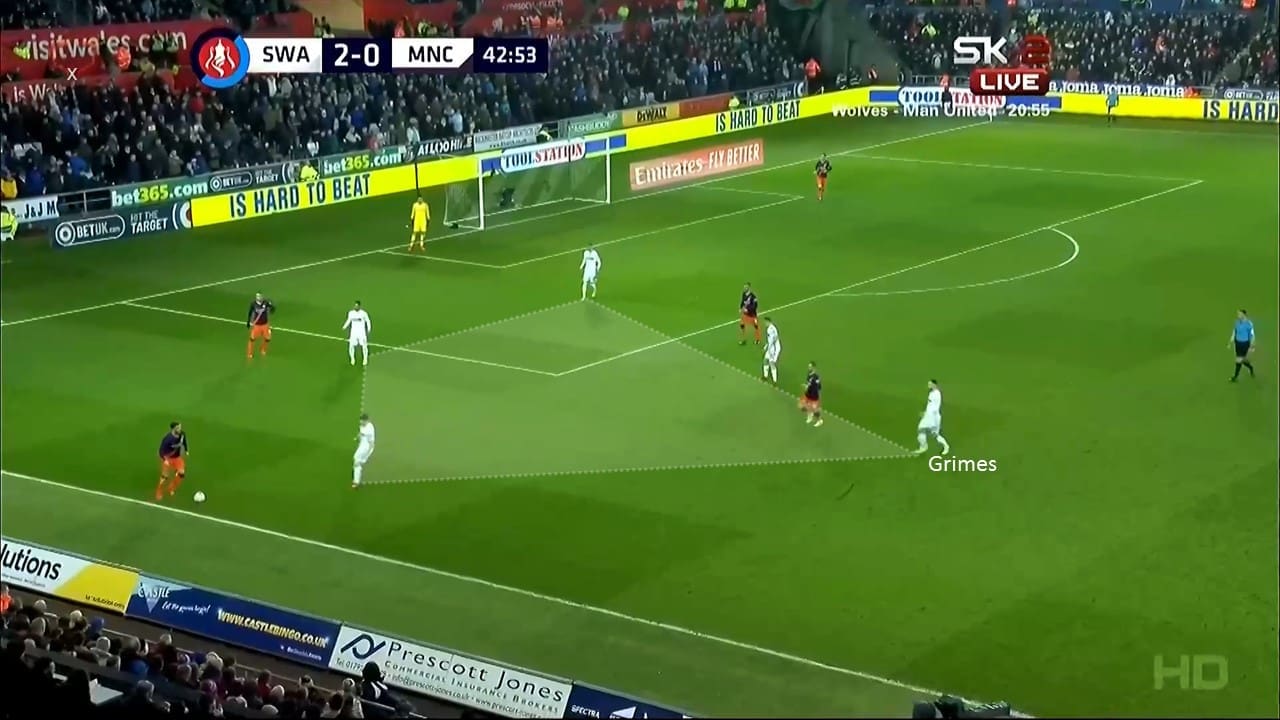
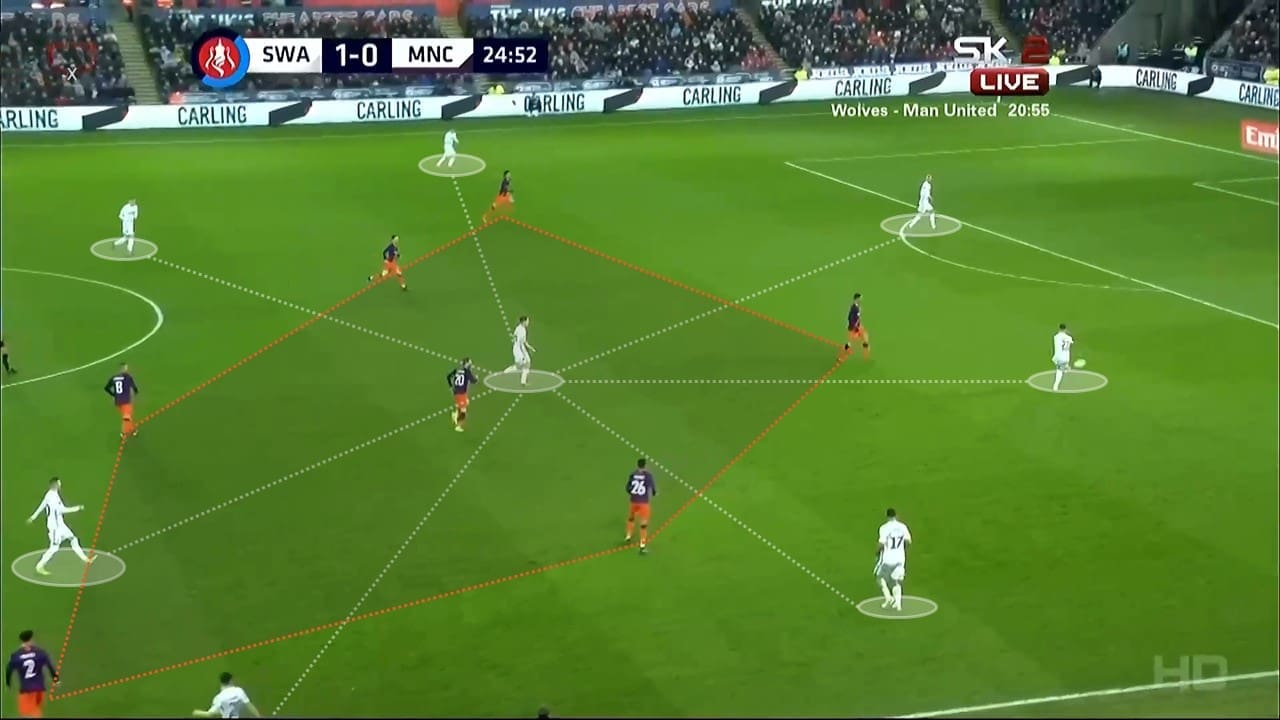
Swansea were also brave in their build-up play. They’ve had mixed results trying to play out from the back in the EFL Championship this season. It failed badly away at Sheffield Wednesday recently and they conceded three first-half goals as a result, but it proved to be far more successful against the Premier League title holders, believe it or not.
To build from the back, Swansea City split their centre-backs wide and either side of their penalty area. To add support to their build-up play, in the example below, Bersant Celina drops deep from his roaming attacking role to help during the first phase.
This tactic proved to be useful later in the first half when the Kosovan helped start a scintillating move that culminated in him finishing at the opposite end of the pitch.
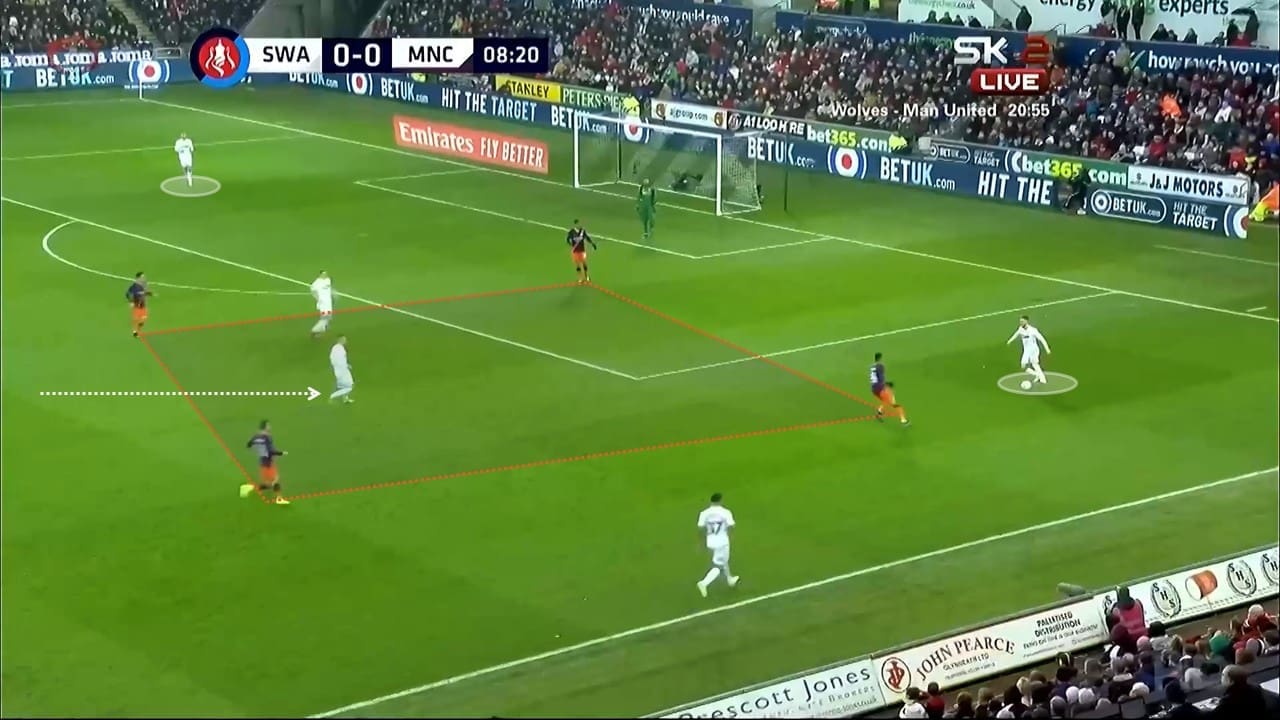
The image below shows the space available if Swansea City can get through Manchester City’s high press.
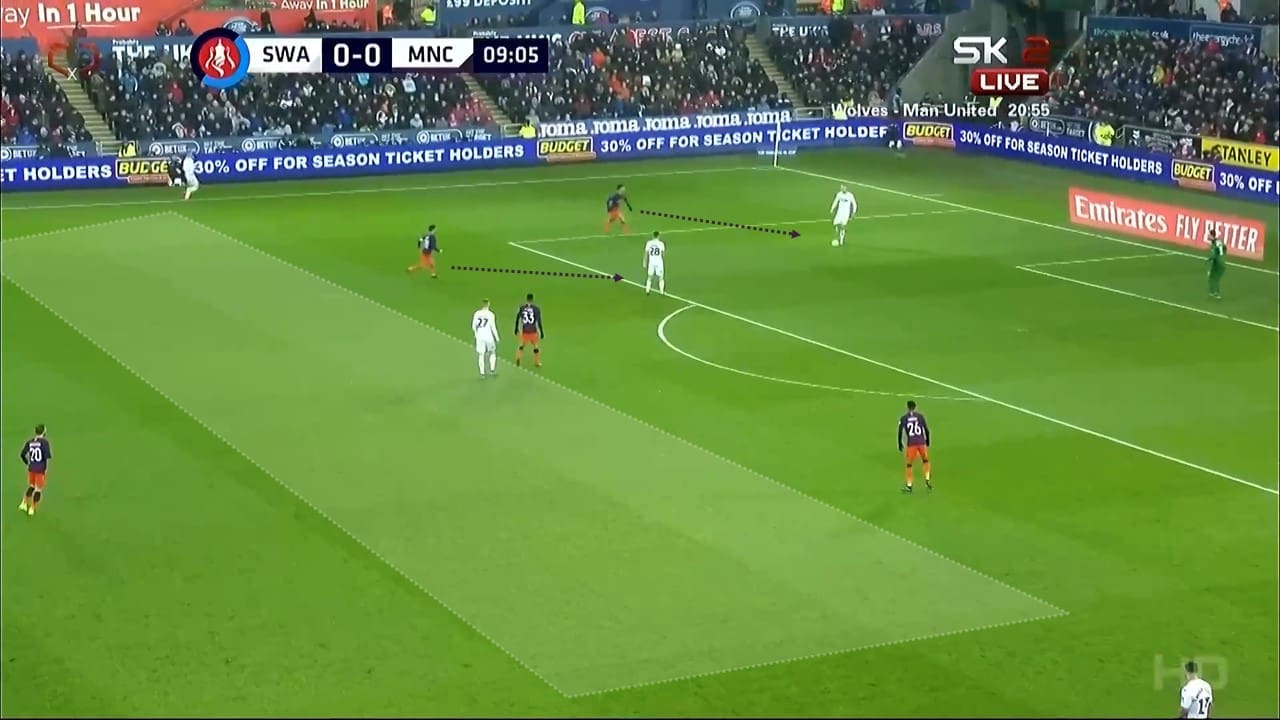
The example below shows how Swansea City could benefit from building from deep and playing vertical passes through the press and into Bersant Celina who found himself in large areas of space.
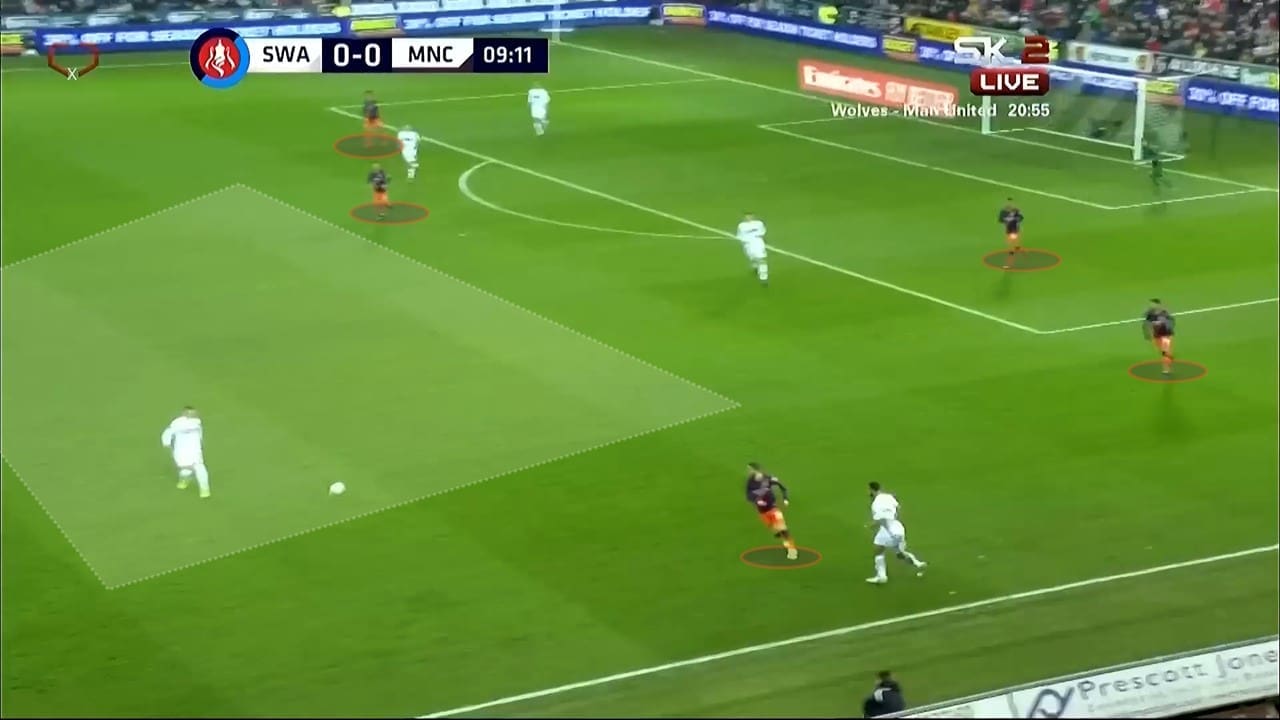
Left winger Dan James was then the next target as an attacking outlet. Whether chasing long balls down the wide channel or receiving balls into feet, the young, flying winger was able to quickly get his team into final-third positions thanks to his blistering pace.
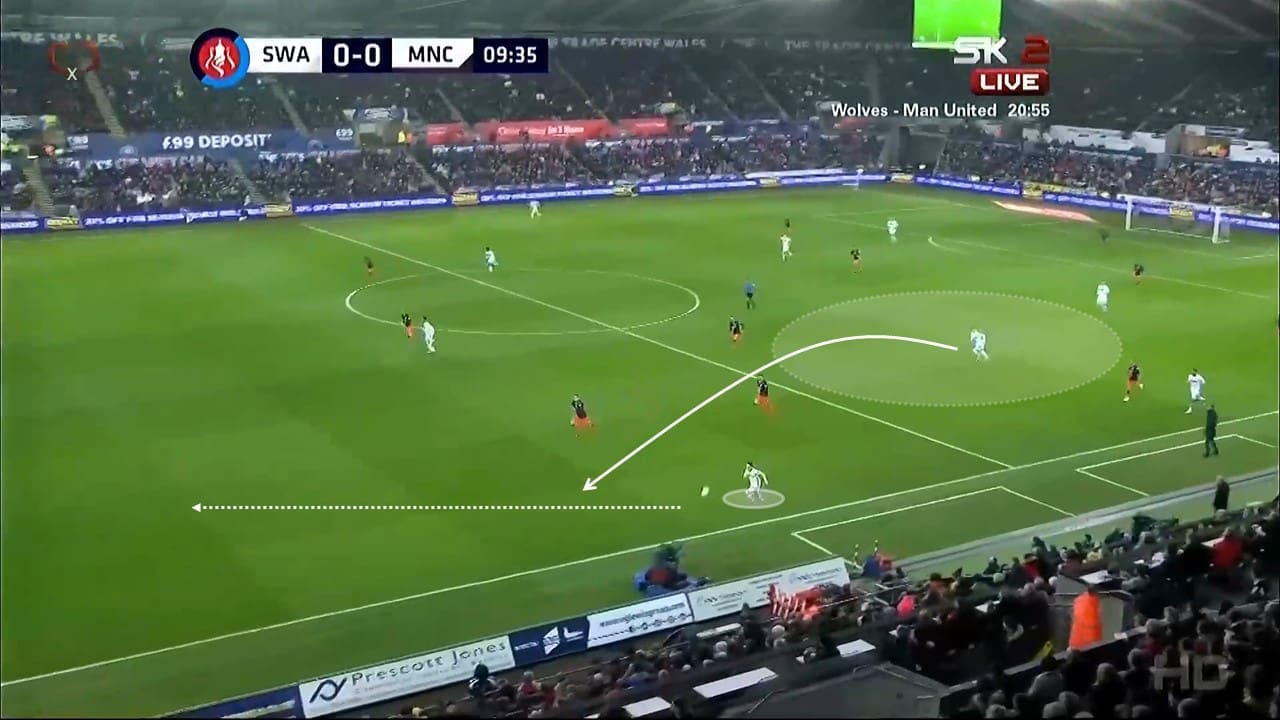
The move finally breaks down for Swansea City as Celina misses a chance to pick out right-back Connor Roberts who was free and available as he cut in from the right, but the quick attacking move provided something of a preview of what was to come in the 29th minute.
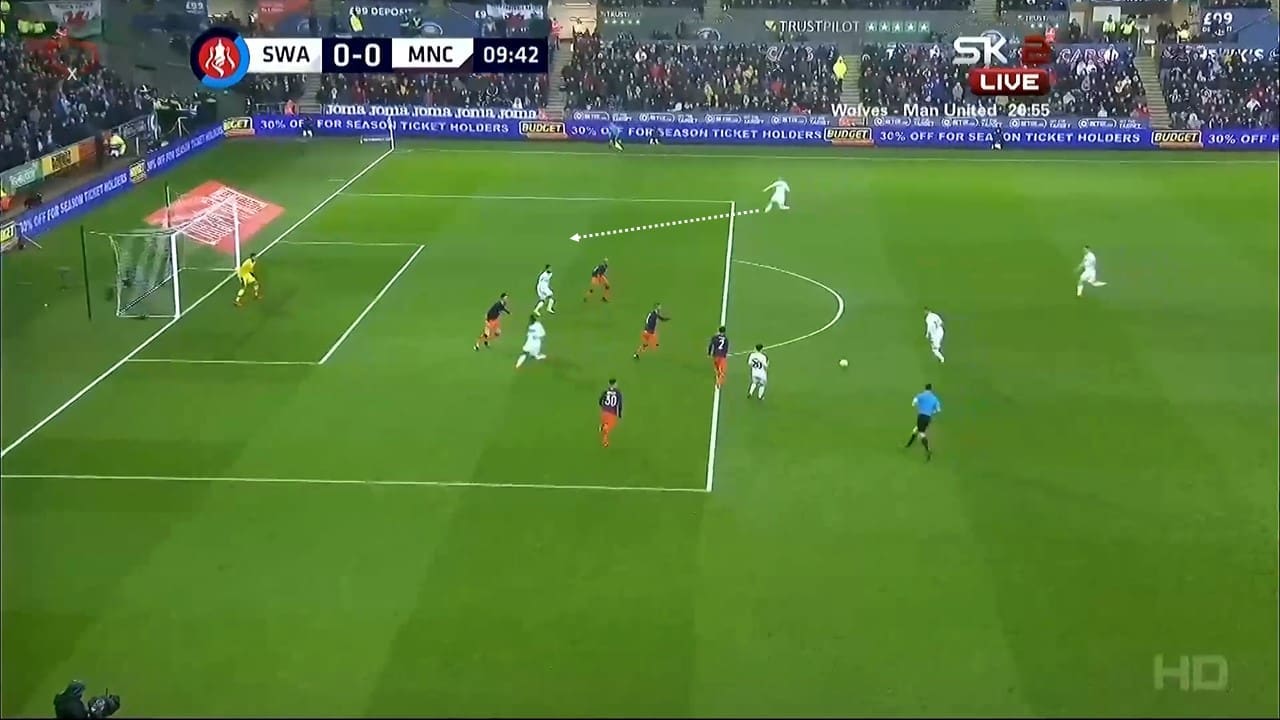
Swansea’s Grimes at centre-back
Swansea City manager Graham Potter has used Matt Grimes at left-back this season and when doing so they’ve missed his influence in a deep midfield position. Following Kyle Naughton’s injury during Wednesday’s defeat at West Brom, Potter didn’t want to waste Grimes’ ability by moving him out of midfield and into left-back.
Instead, he simply moved him into a centre-back role. Swansea have played out from the back with a back three this season so this wasn’t exactly a completely new role for the 23-year-old as he found himself in similar positions when in possession.
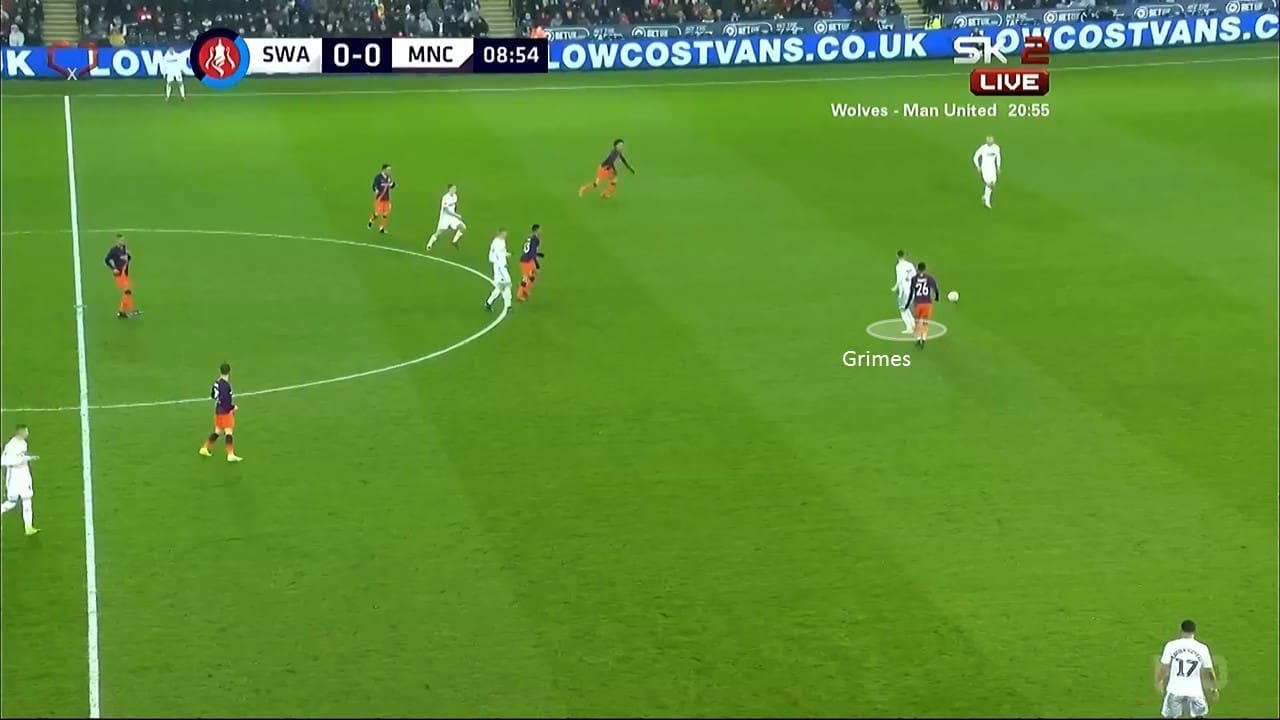
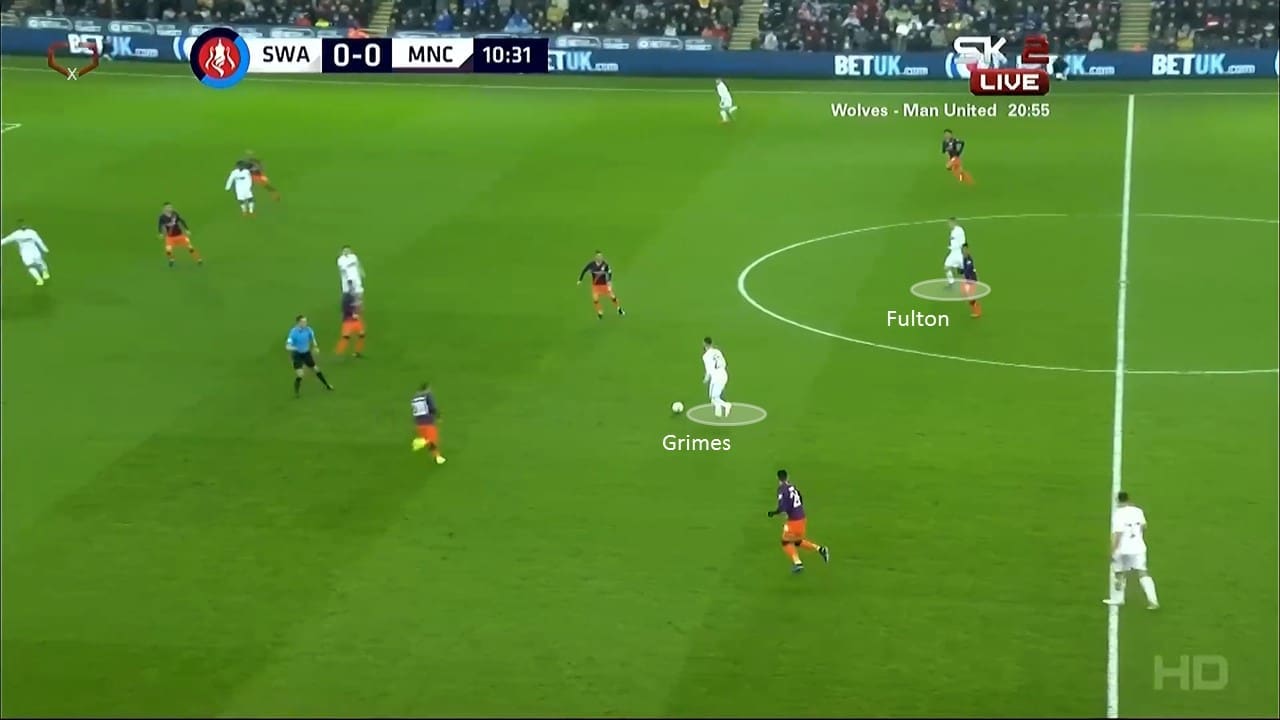
Jay Fulton came into the starting line-up to offer defensive support, giving Matt Grimes licence to move into a midfield role when his team were in possession.
With Dan James hugging the left touchline and right-back Connor Roberts getting forward on the opposite side, Swansea could afford to have defender Carter-Vickers at left-back as he wasn’t needed for providing attacking width. Potter has preferred his full-backs to offer width while his wingers cut inside to support the central attacker, but he shuffled things around in this FA Cup tie to make it work with the players he had available.
Manchester City’s space in wide areas
Manchester City looked to take advantage of the space that was available in wide areas against Swansea’s narrow defensive shape. But as mentioned earlier in the analysis, excellent saves, a packed penalty area and some luck ensured that they were kept out for 69 minutes.
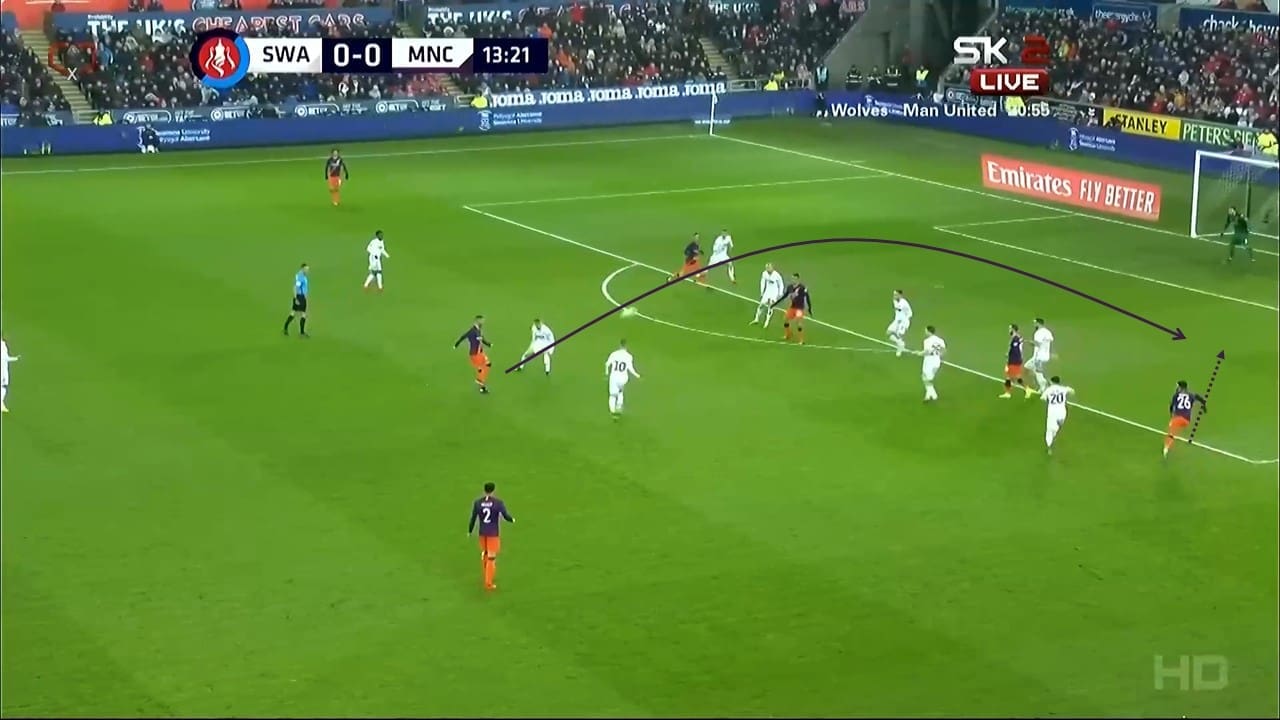
Manchester City were excellent throughout the game at switching the play and getting the ball into wide areas where they were able to find open space. Below, they switch the play over to Sane on the left after Mahrez cuts inside but Sane’s first-time cross is poor and overhit.
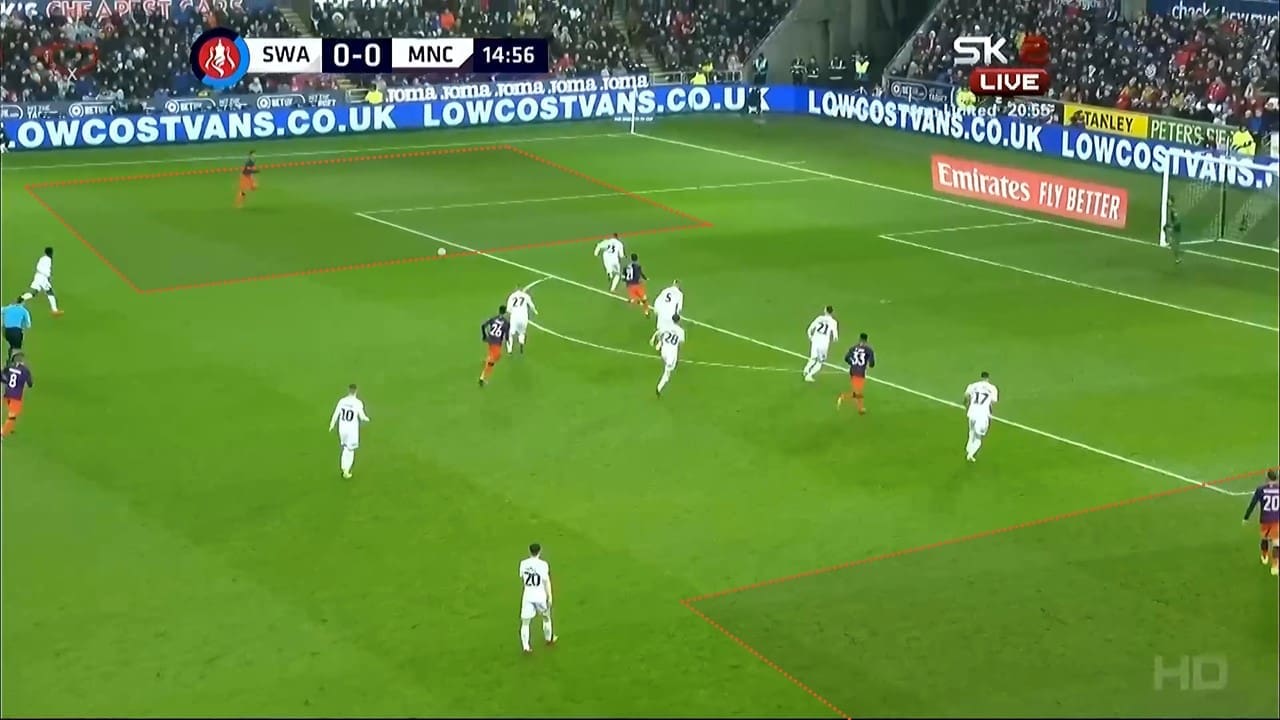
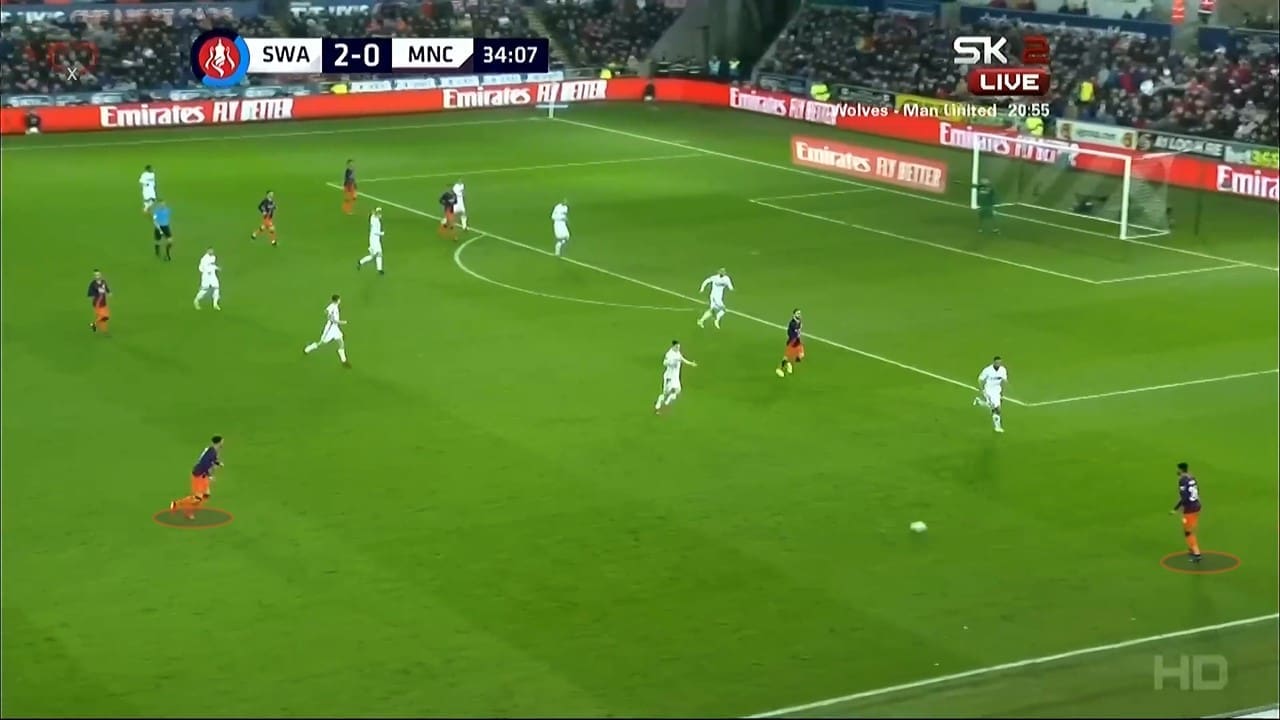
Manchester City were busy and dangerous in wide areas. In an effort to close off the space, Swansea doubled up with Nathan Dyer and Dan James dropping deep as cover (below).
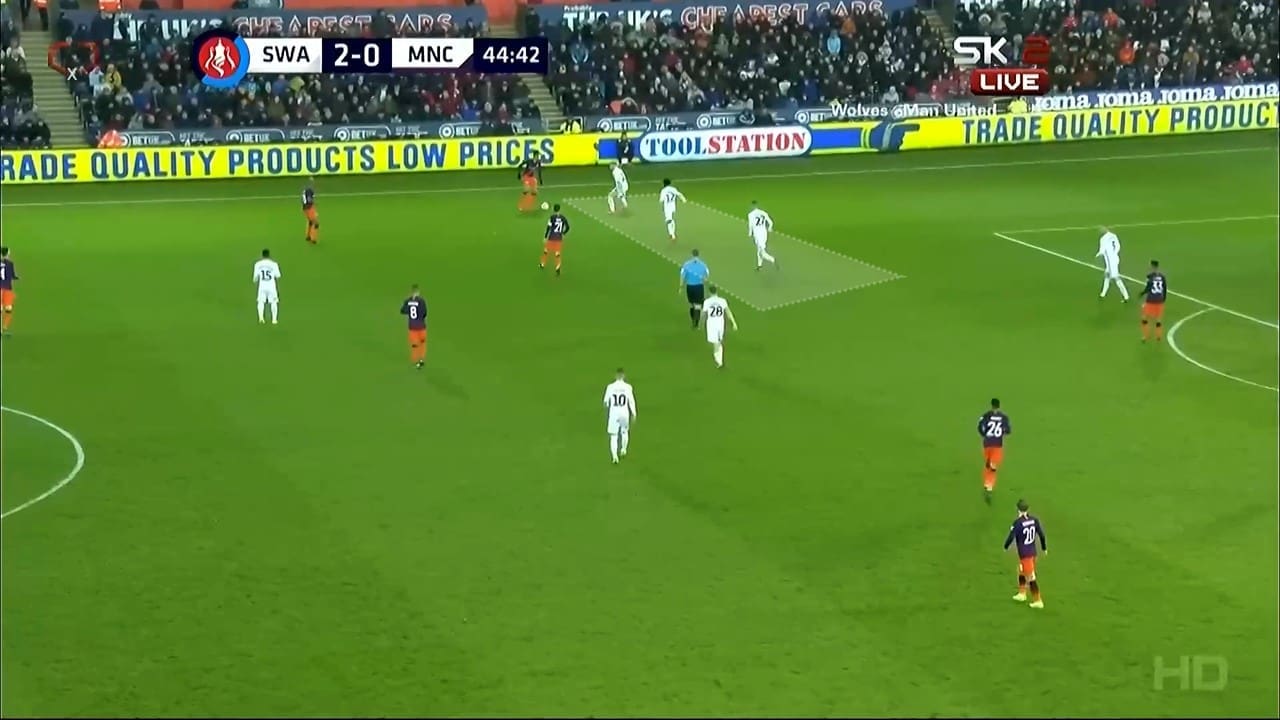
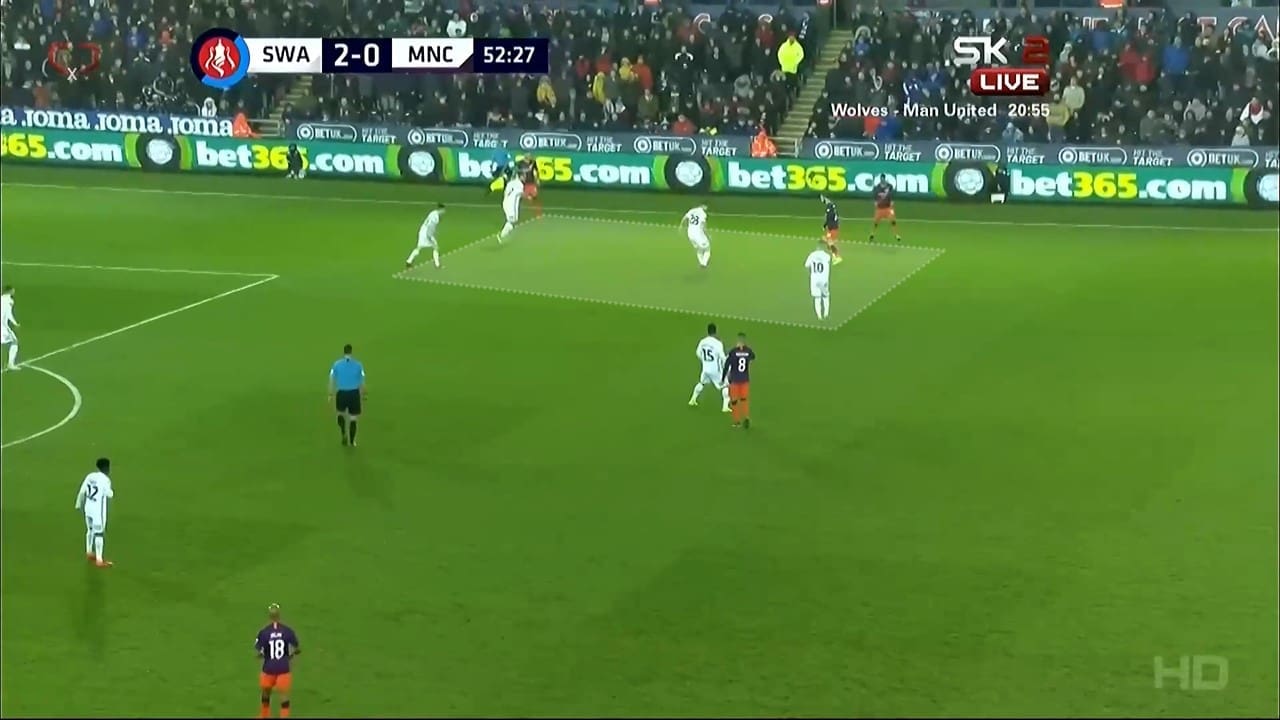
Swansea City have missed opportunities too often this season to switch the play and move it away from congested areas to space on the opposite side. They were better at it on Saturday, however, and generally less hesitant in possession.
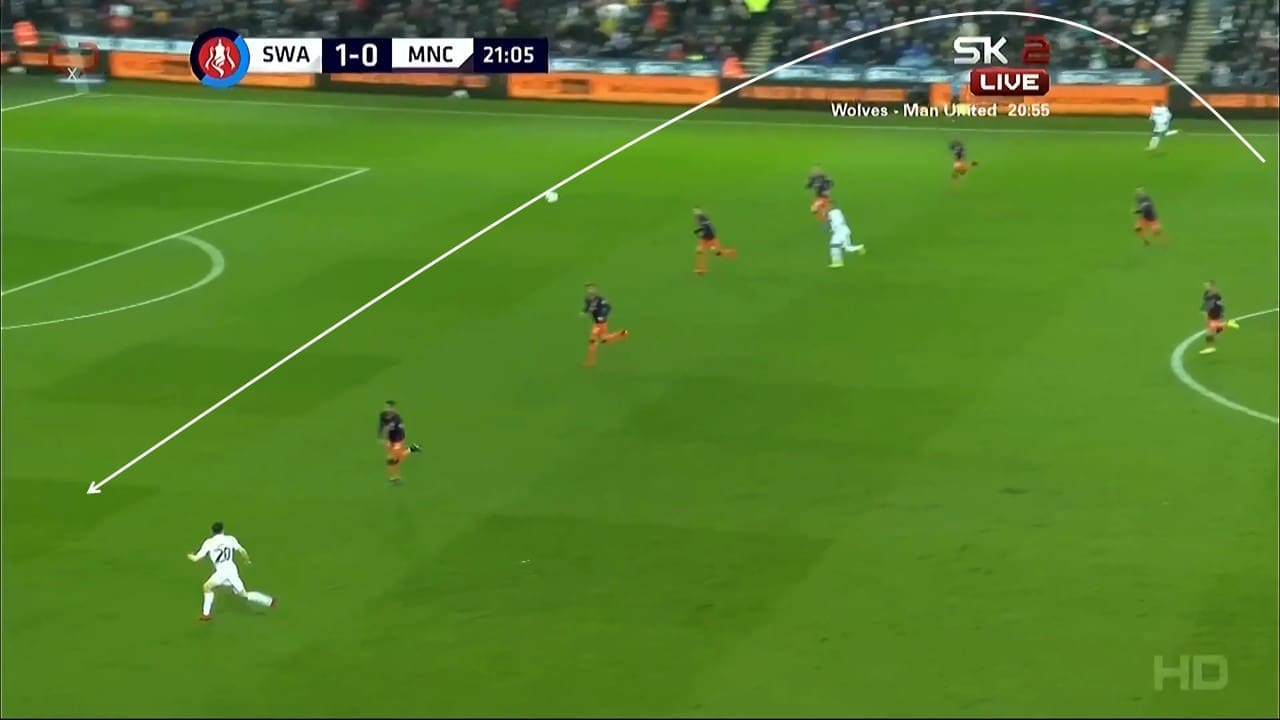
Although not strictly a switch of play, Swansea’s right centre-back Van der Hoorn hit a long pass out to right-back Roberts who provided useful attacking width down that side during the game.
The Welshman’s neat first-time touch inside of Fabian Delph got him past the left-back, but the former Aston Villa man pulled him back inside the penalty area. After Celina’s spot-kick miss at West Brom, Matt Grimes stepped up and sent Ederson the wrong way to put the hosts into a 1-0 lead.
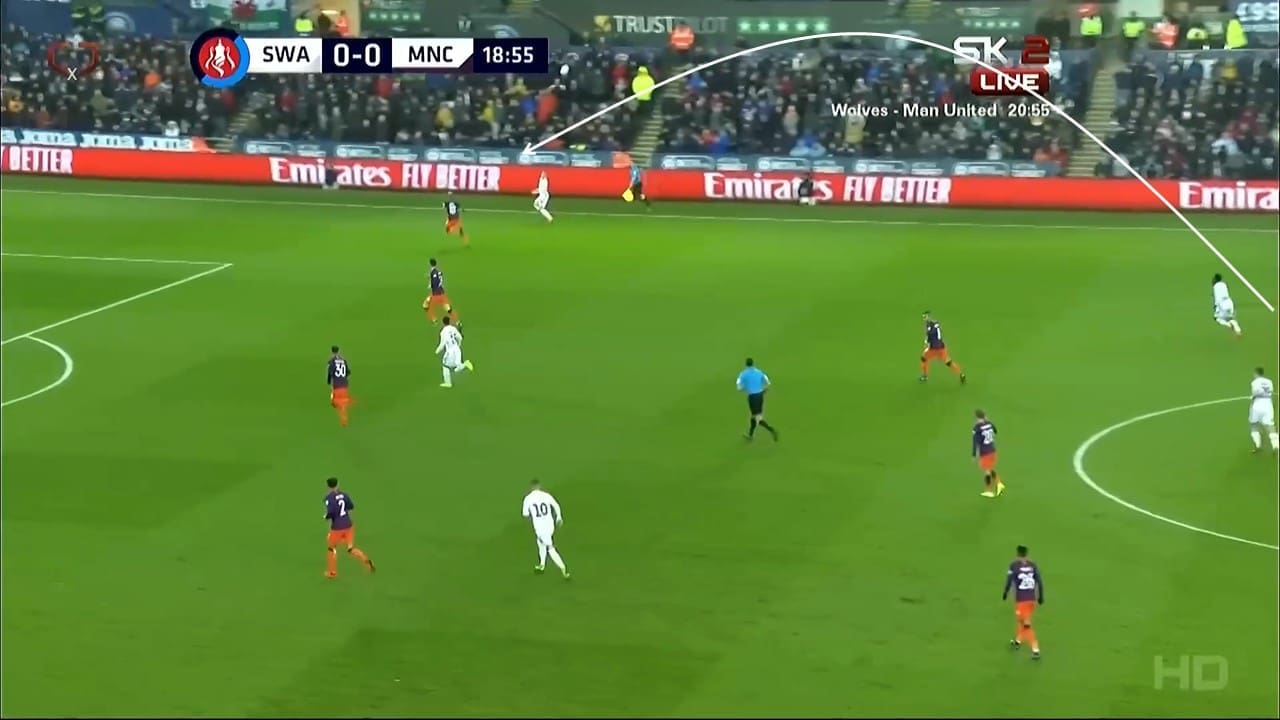
Bersant Celina’s space in between the lines
Bersant Celina spoke of his desire to prove a point to his former club and he certainly impressed as he proved difficult to mark in between the lines in both halves of the pitch. In the example below, Matt Grimes has moved wide and deep in a typical position for a centre-back in a side that like to build from a back.
Celina drops deep as an option in the second phase of the attacking build-up in space as Manchester City didn’t always pick him up. As a result, they were later punished as he helped create Swansea’s second goal.
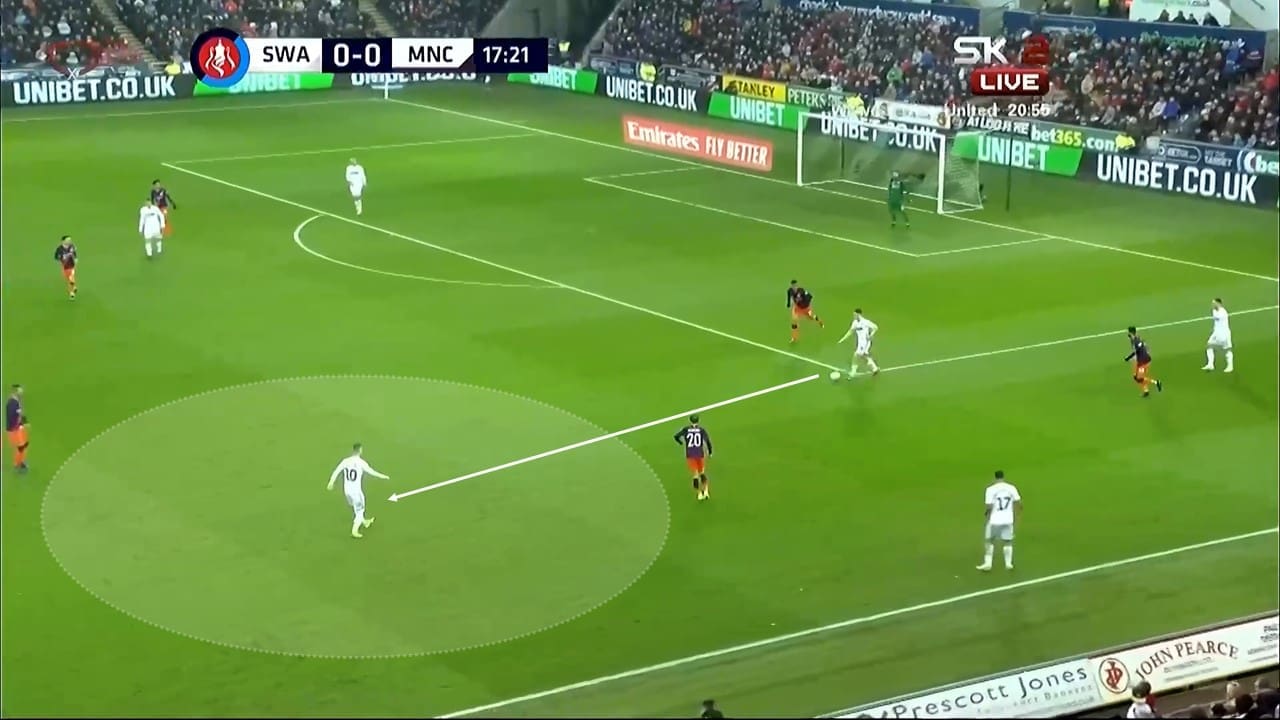
As the attacking move progresses further up the pitch, Bersant Celina joins the attack as Manchester City are too slow to follow his runs through the middle. He plays a one-two with Routledge but the winger miscontrols the return pass and possession is lost.
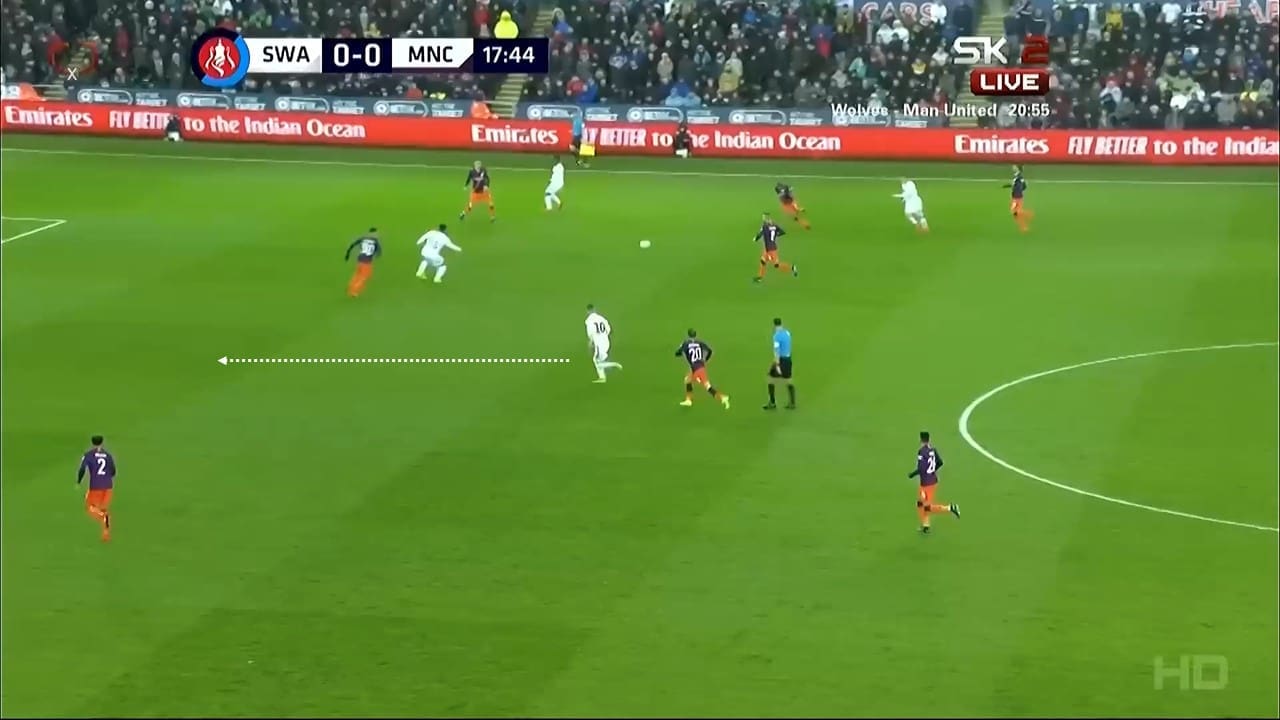
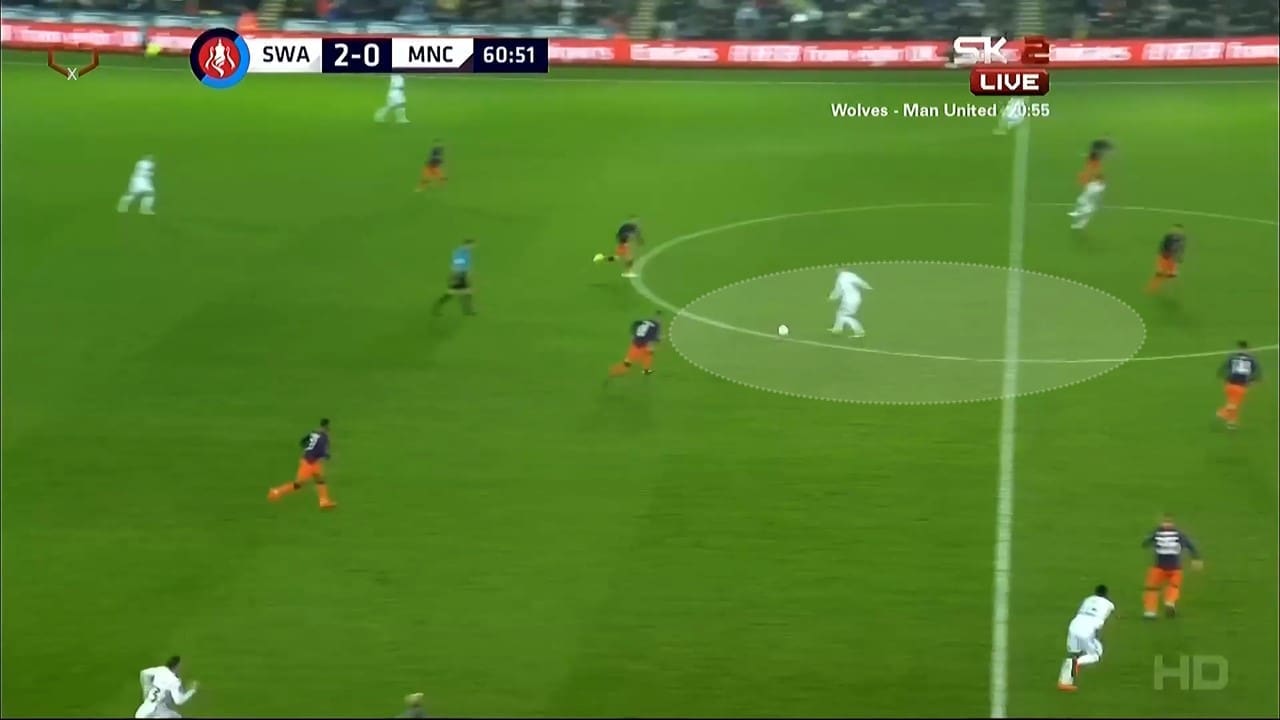
He who dares, wins
Swansea City were rewarded by their bravery and confidence in sticking to their principles by playing out from the back as per Graham Potter’s philosophy. As mentioned earlier in this analysis, Swansea City were able to cut through Manchester City’s press, using Bersant Celina’s creativity on the edge of both penalty boxes to create chances from one end of the pitch to the other.
And as we saw earlier, Swansea’s second goal was another move that started with Celina dropping deep, making a free run through the middle before finishing a glorious move past Ederson. The move starts with the goalkeeper, Kristoffer Nordfeldt, who’s able to play a forward pass to George Byers. Gabriel Jesus blocks a passing lane to Jay Fulton, leaving enough space for the Swede to pick out Byers instead who’s unmarked.
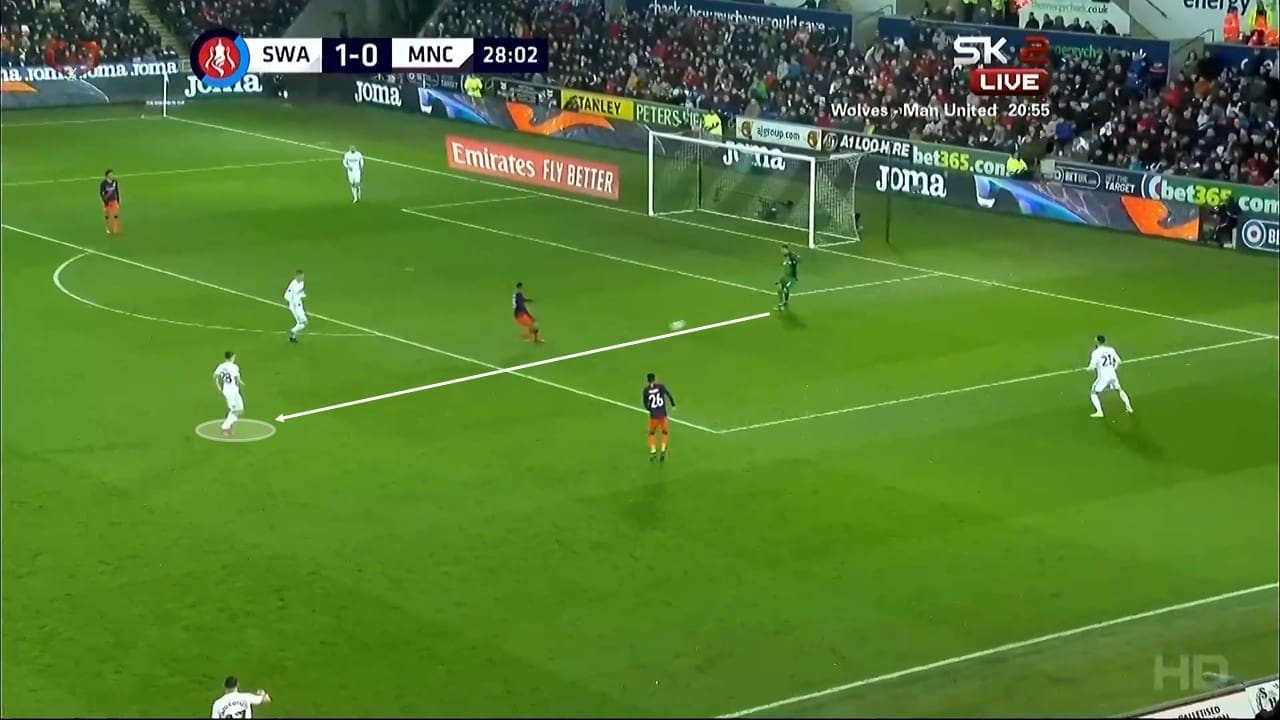
The image below shows the area of free space for Bersant Celina to work with as George Byers plays a forward pass to him. Manchester City have two players inside Swansea’s half on the right side of the pitch, anticipating passes out near to that touchline. This leaves Celina, and more importantly Dan James, in space to get in behind.
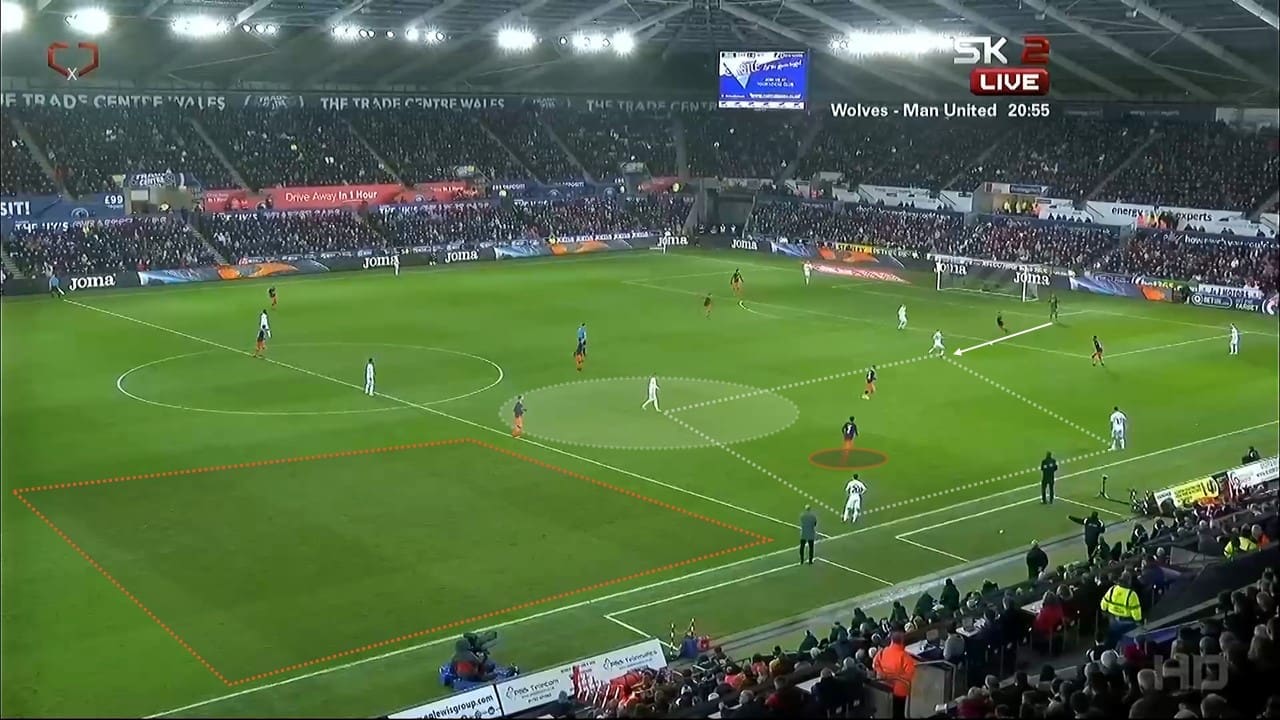
Kyle Walker pushing forward into Swansea’s half forces a Manchester City defender to come across as Celina releases Dan James down the left. As the defender moves across, this leaves a large area of space for Celina to run into as he joins the attack. Nathan Dyer, currently running through inside the centre circle, will also soon get involved to provide the assist.
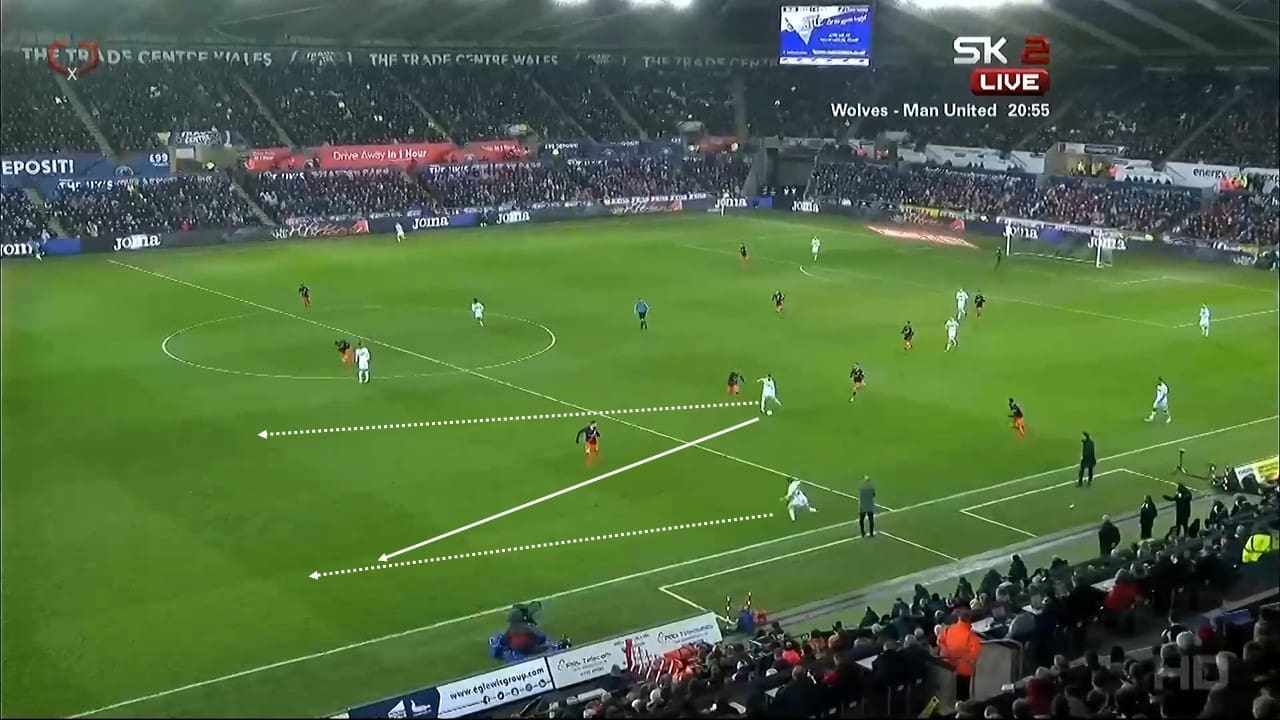
Considering Dan James’ pace down the left, Nathan Dyer makes up excellent ground as he too joins the attack through the centre. As the image below shows, Dan James picks out Dyer with an inside pass.
Dyer’s first-time pass through for Celina gets him into a great position inside the area as he curls a first-time shot past the goalkeeper. It was quick, incisive and clinical. The image below also highlights Gundogan who was too slow to track back and follow Celina’s third-man run.
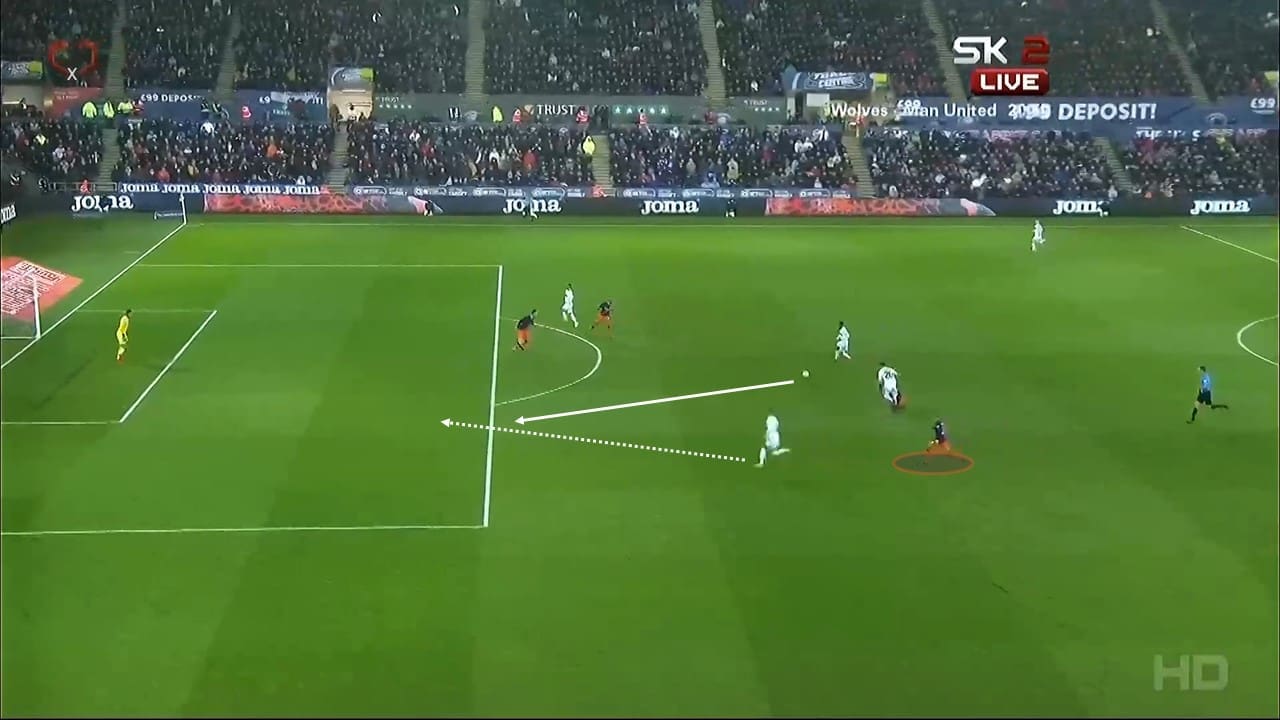
Swansea switch to a back five
Swansea City maintained their high press in the second half but it was evident that they were tiring as time went on. Later, they switched to a back five to cope with Pep Guardiola’s attacking substitutions, using all three by the 64th minute.
Courtesy of Wyscout, the graphic below shows Swansea’s player position changes during the game. In the final 20 minutes, Potter switched to a 5-4-1 with Jay Fulton dropping back as a third centre-back with Declan John coming on at left wing-back, allowing Grimes to move into his natural midfield role.
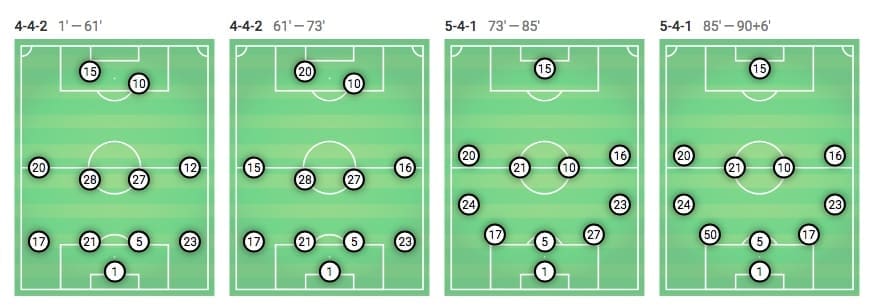
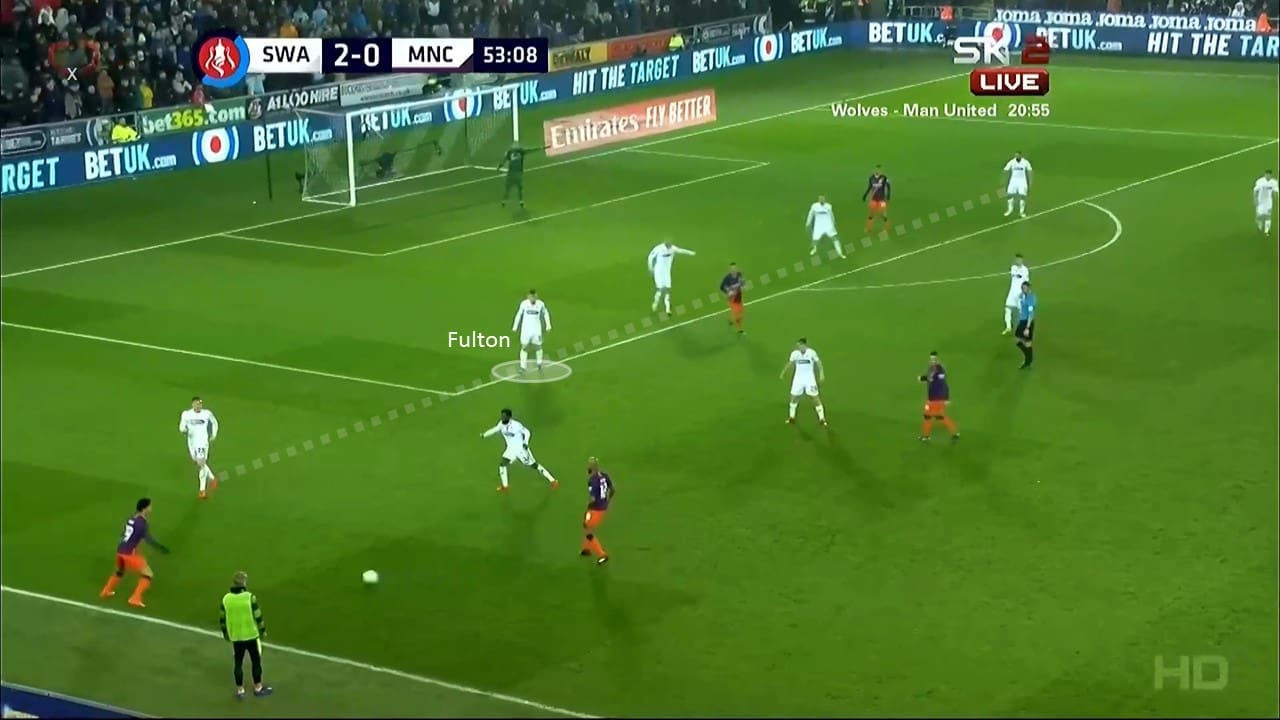
Pep Guardiola’s first substitutions, in the 57th minute, saw Leroy Sane and Fabian Delph make way for Raheem Sterling and Oleksandr Zinchenko. Sterling played on the right of a front three with Bernardo Silva moving to the left. Seven minutes later, Sergio Aguero replaced Riyad Mahrez to boost their attack.
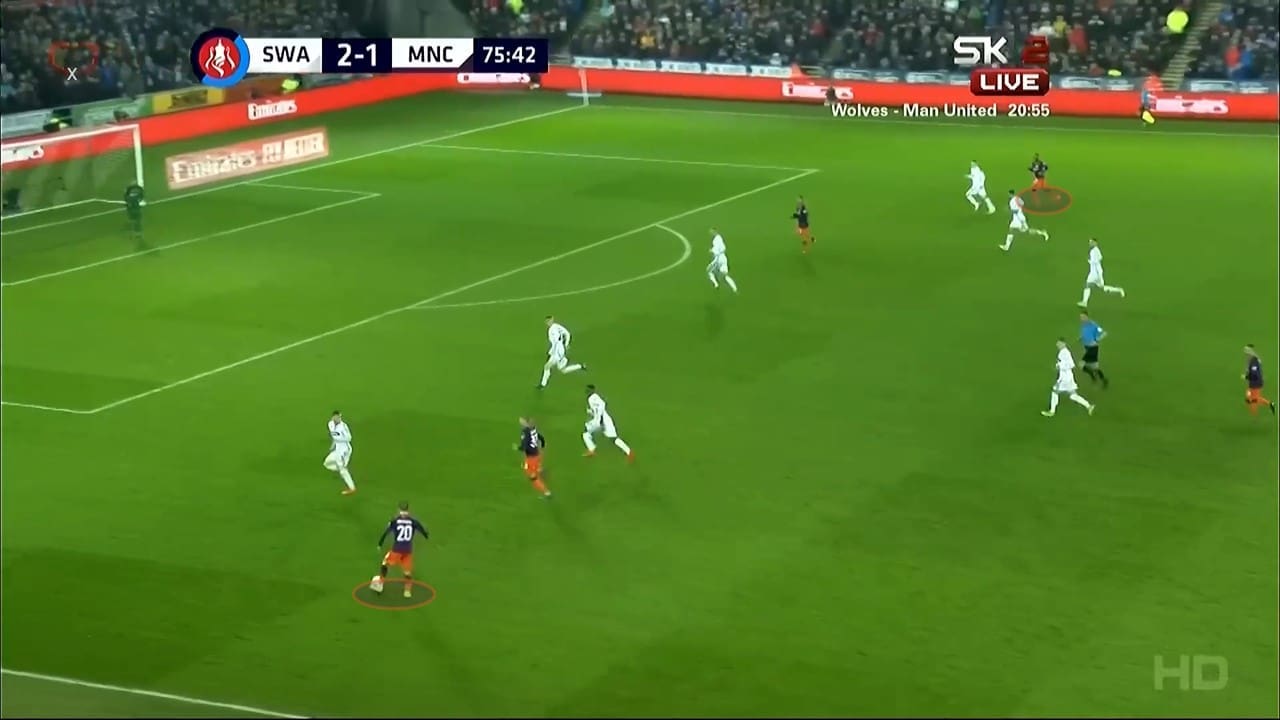
Bernardo Silva was joined by Zinchenko who offered an inside option. Ultimately, Manchester City had more dynamism down the left as they looked to get through Swansea’s back six, as Nathan Dyer dropped deeper on that side.
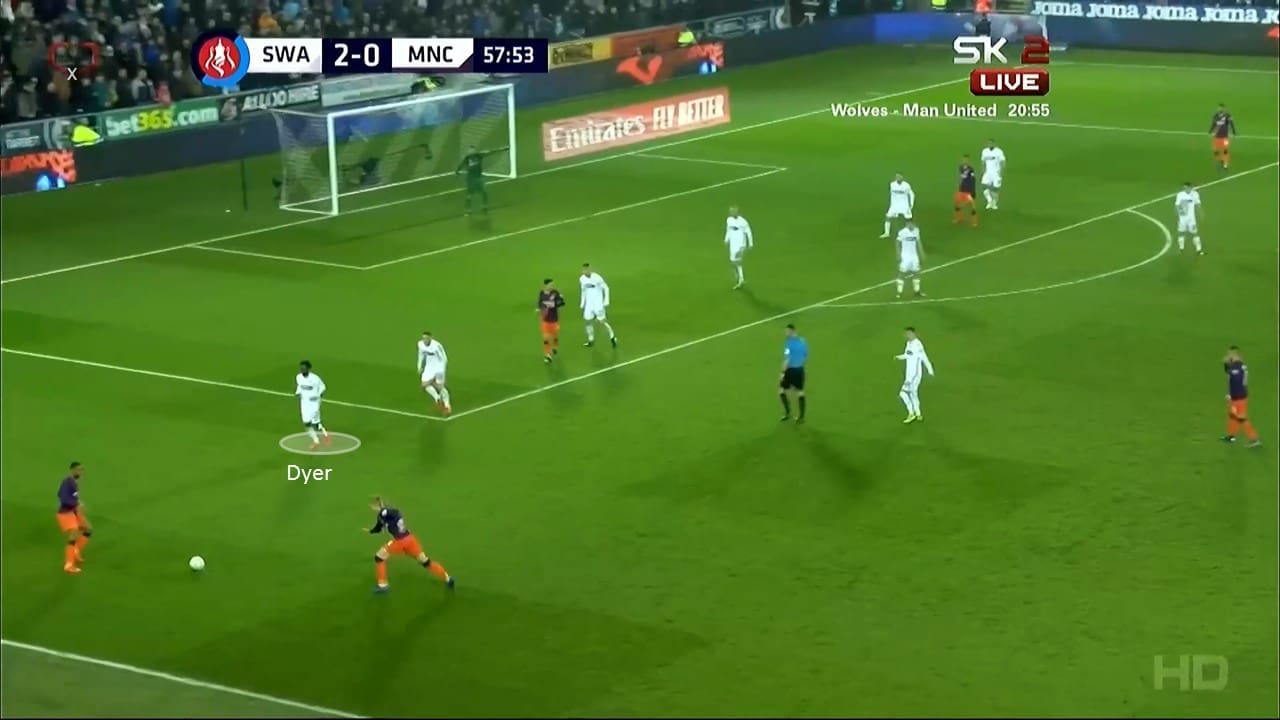
Manchester City get a goal back and controversy follows
Manchester City got on the scoresheet in the 69th minute after Connor Roberts miskicked a clearance following a cross from the right. With the ball hanging around in the penalty area after the failed clearance, a shot was blocked by Jay Fulton, but Sergio Aguero was able to get the ball out to Bernardo Silva on the left to arrow a shot past the goalkeeper and into the far corner of the net.
Despite facing such a talented attacking side in Manchester City, Swansea would have been disappointed to concede in the manner they did. The missed connection from Roberts was uncharacteristic from the Welsh international, allowing Silva plenty of space to fire a shot at goal as substitute Joel Asoro couldn’t get across quickly enough.
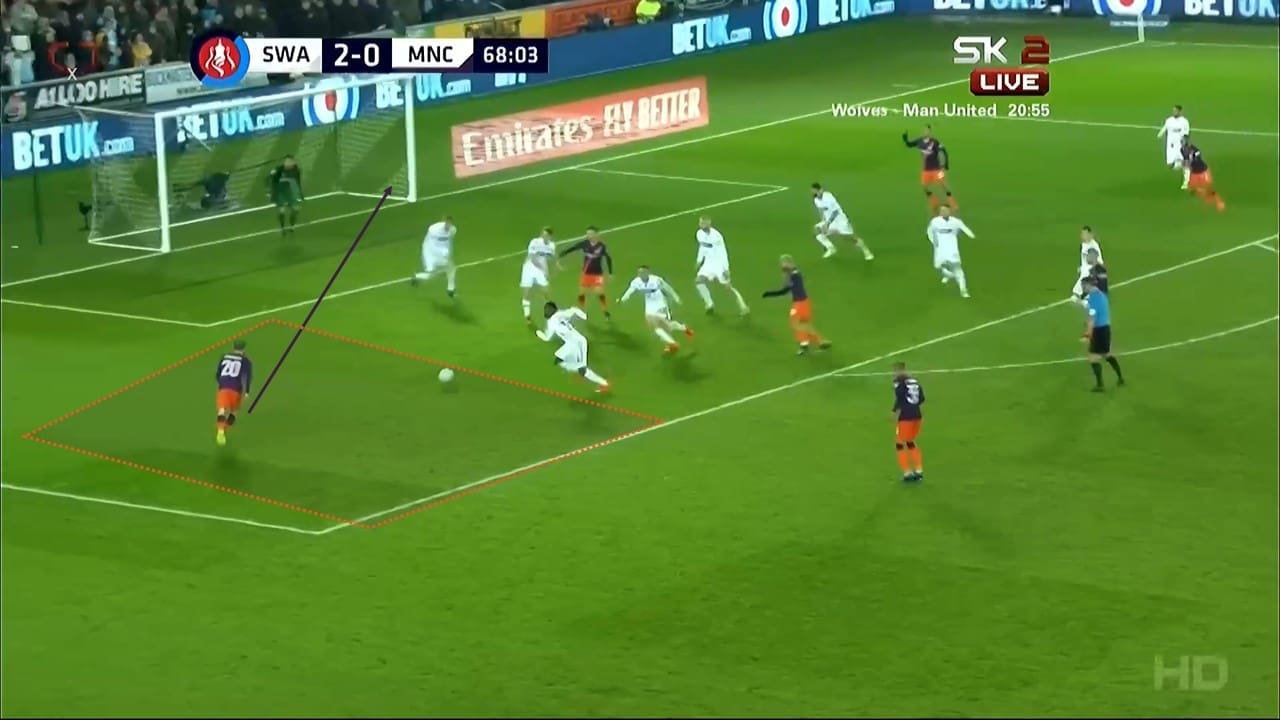
Nine minutes later, Manchester City were given a huge chance to go level with 22 minutes left to play as the referee pointed to the spot when Sterling looked to get past Carter-Vickers. The Spurs loanee looked like he had got a touch on the ball, making a crucial challenge to concede the corner, but the referee didn’t hesitate in awarding the spot-kick.
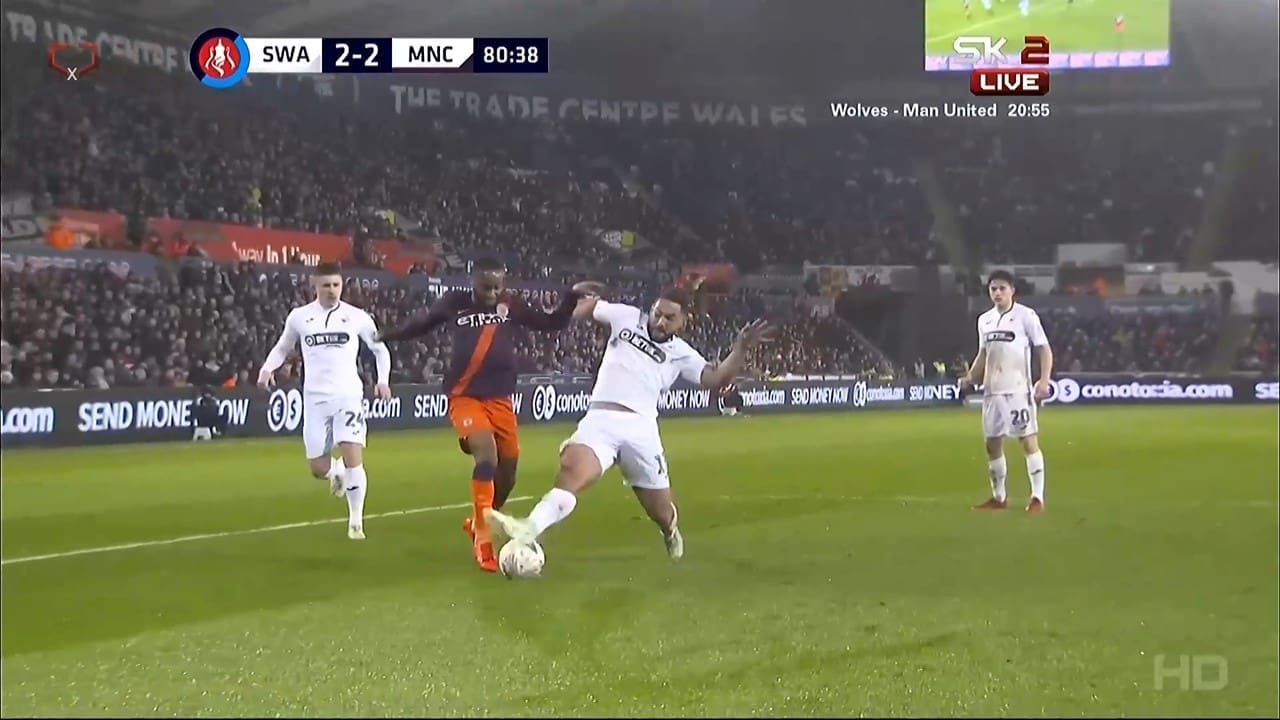
Sergio Aguero’s penalty came back off the inside of the post and dropped over the line after taking a deflection off the goalkeeper. The turnaround was complete for Manchester City with just two minutes of normal time remaining, and there was further controversy. Aguero appeared to be standing in an offside position as he glanced a header past Kristoffer Nordfeldt.
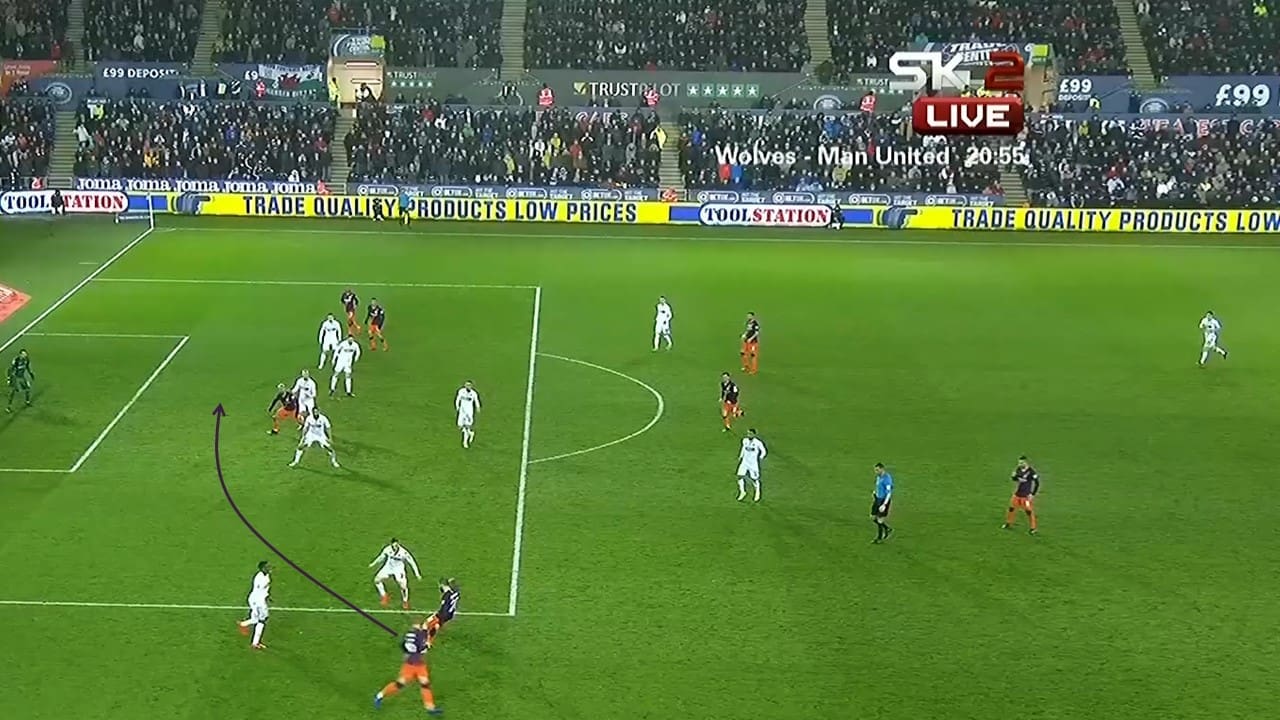
Conclusion
It was an enthralling FA Cup quarter-final tie between two sides that looked to get on the front foot, press high and attack with quick transitions. The high press was a key factor in the game as they both looked to invite the press, bypass it and use the space in behind it.
Remarkably, it was Swansea City who were clinical and made the most of their early openings as Bersant Celina proved difficult to track for his former club. Graham Potter and his players can be very proud of their performance, deservedly taking a 2-0 lead thanks to some brave and bold tactics that left Pep Guardiola shocked on the sidelines.
They rode their luck at times but Swansea held firm for almost 70 minutes before the late drama and controversy started. A highly debatable penalty decision and an offside goal begged the question why VAR wasn’t in use, but nevertheless it was a proper cup tie full of quality.
If you love tactical analysis, then you’ll love the digital magazines from totalfootballanalysis.com – a guaranteed 100+ pages of pure tactical analysis covering topics from the Premier League, Serie A, La Liga, Bundesliga and many, many more. Buy your copy of the March issue for just ₤4.99 here, or even better sign up for a ₤50 annual membership (12 monthly issues plus the annual review) right here.

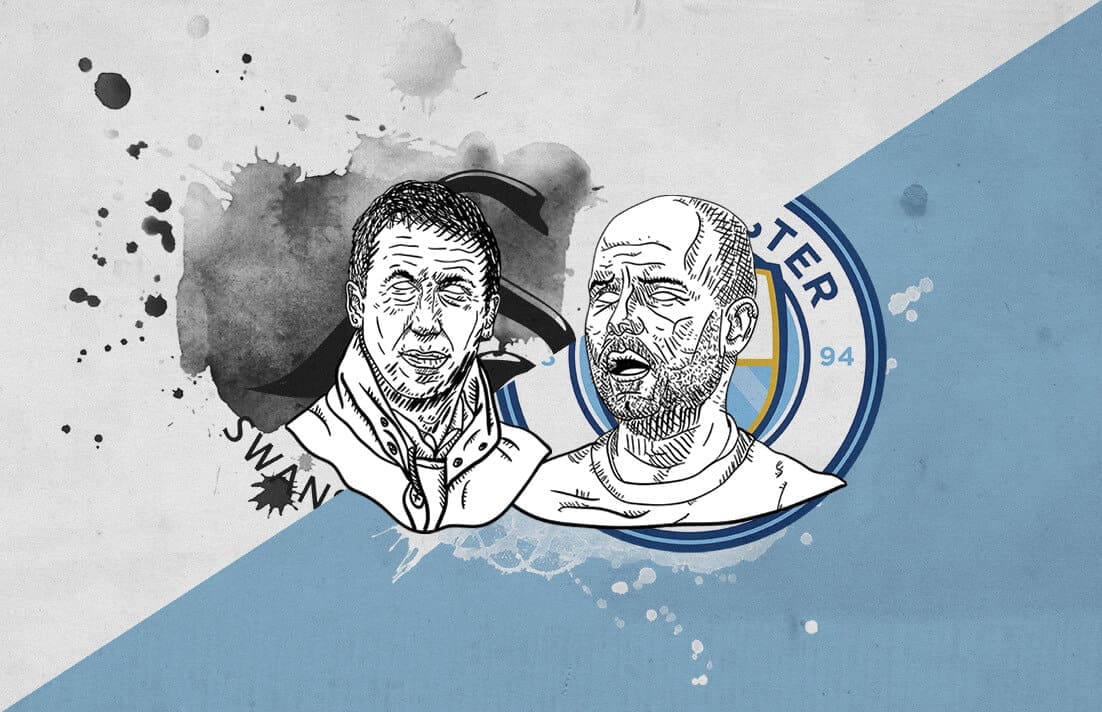




Comments